Four Countries in Southeast Asia
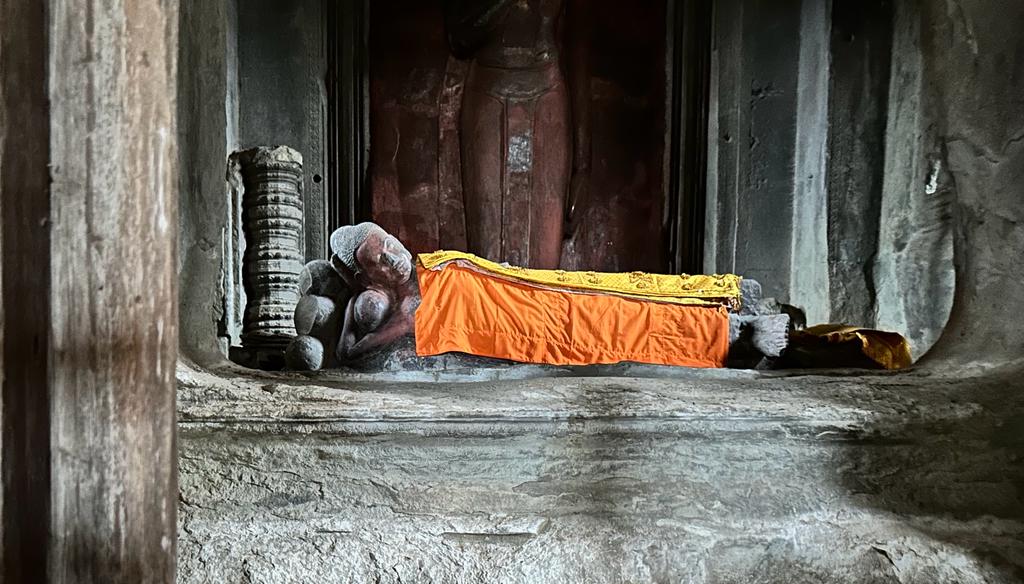
Cover: Reclining Buddha, Angkor Wat, Cambodia
In which part of the world do we see spirituality and tranquility blend with nature? The Southeast Asian countries of Vietnam, Cambodia, Laos and Myanmar exemplify these words. In addition to the beauty we see, these travels also open our eyes to the suffering around the world and we come away with rather indescribable feelings that we attempt to put into words.
What’s on this page?
While the ‘Trip Experiences’ section is a personal travel narrative, some long blog posts have a ‘Highlights’ section which is a summary of the popular tourist destinations, their short descriptions and pictures, presented in collapsible sections (+ to open, – to close).
Contributor Credits
My friend Neeta recently had a very memorable trip to Asia for 17 days, covering the countries of Vietnam, Cambodia, Myanmar and Laos. She gave me a beautiful account of her experiences. Thanks Dr. Neeta Nayak for your contribution with pictures. Also, thanks to her husband Sudhakar for being part of the narrative.
Also, on this Travels to Savour website, checkout a separate blog on Myanmar/Burma for more specific information on cities in Myanmar.
— Jyothi
Trip Experiences and Highlights
Weaving through parts of Southeast Asia
A detailed narrative of Neeta’s travel will take you through the rich tapestry of history, culture, spirituality, beauty and nature. One will never be able to ignore the ravages caused by a long war, tyranny of guerrilla movement, violent conflict and human suffering in these places. Read on….
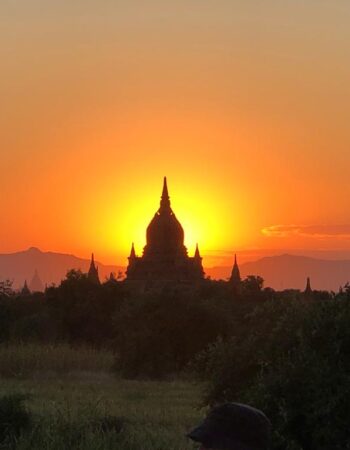
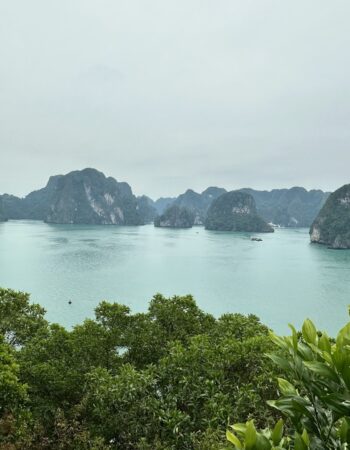
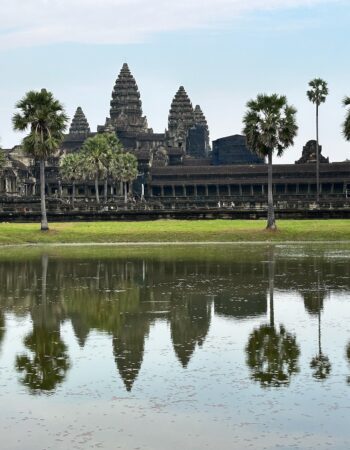
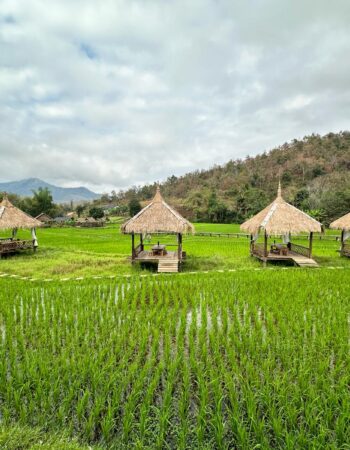
DESCRIPTION AND PICTURES (+ TO OPEN, - TO CLOSE)
We have landed in Brahma desha !!! The land of Lord Brahma, the creator of the universe. Brahma apparently became Burma desha and the people were called Burmans!!! Changed to Myanmar to represent national identity (from Mranma or Myanma – the local tribe).
Myanmar is known as “Land of the Golden Pagodas”. Almost all these Southeast Asian countries are overwhelmingly Buddhist. The Buddhas are of three kinds- standing, sitting and reclining. 89% in Myanmar and almost the same amount in Vietnam. They have very serene pagodas.
We stay overnight at Park Royal hotel. Room service at Park Royal Hotel- a very nice presentation of Mezza appetizer with Chickpea hummus, eggplant babaganoush, yogurt tzatziki, crispy cheese and pita. The pita bread that looks like a Pani Puri. So creative of the Indian Chef that runs their kitchen!
Yangon (formerly Rangoon)
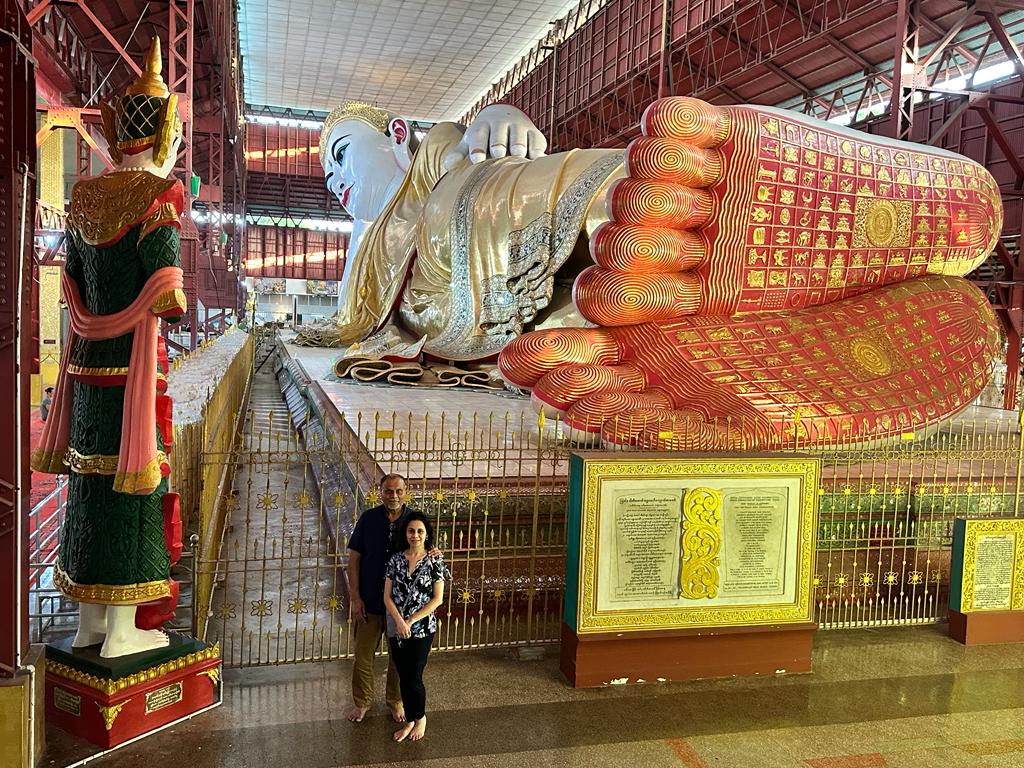
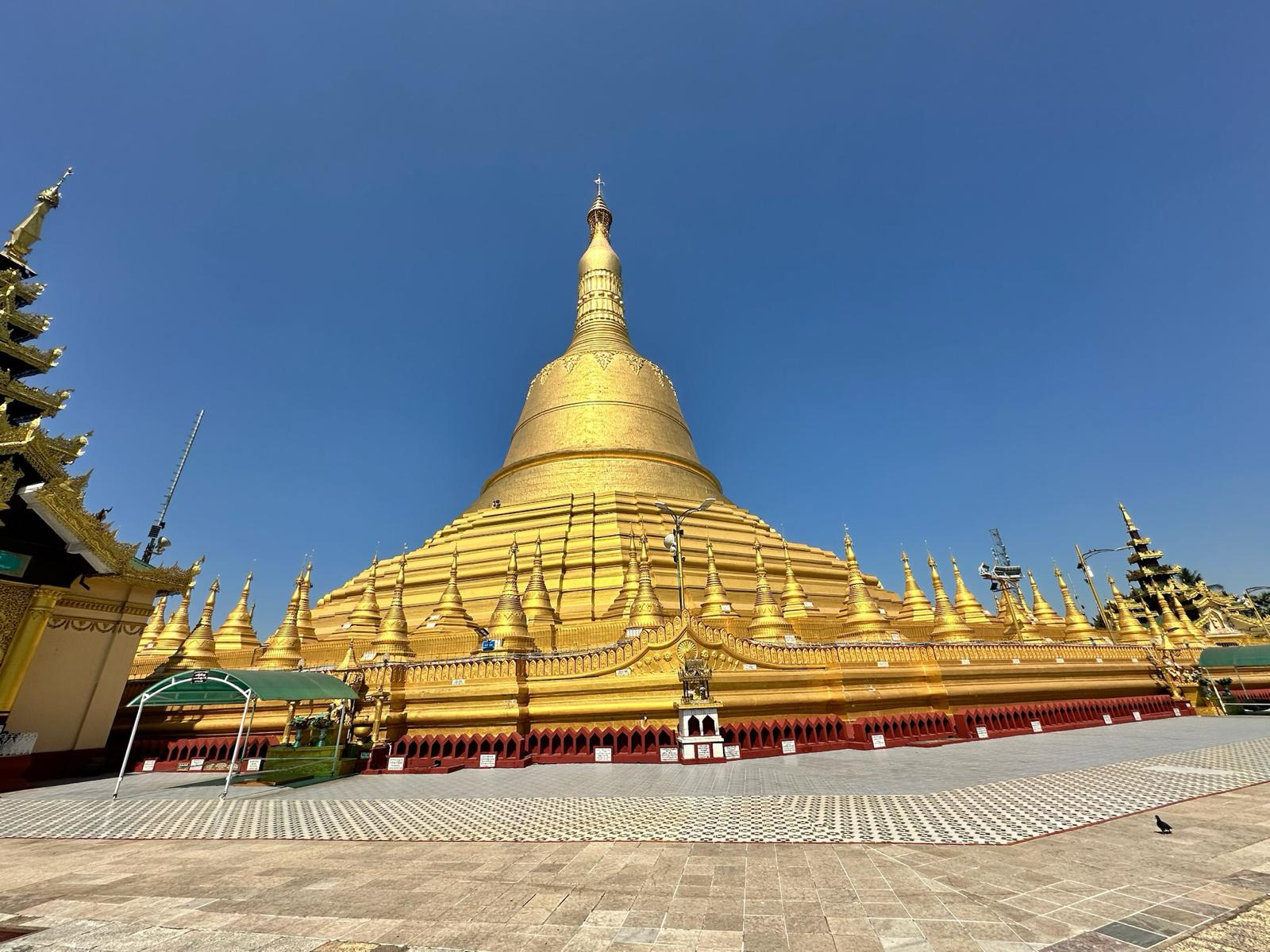
- Located near Kandawgyi Lake in Yangon, the Chaukhtatgyi pagoda is one of Myanmar’s most famous Buddhist pagodas. A prominent attraction in the town is the 65-metre-long reclining Buddha. The feet are highly ornate. Learnt about the 108 marks on his sole representative of the 3 worlds, 59, indicating the inanimate world (okasaloka), 21 indicating the animate world (Sattaloka) and the remaining 28 representing the world of the conditioned (Sankaraloka). How small and insignificant we are at the feet of this massive reclining Buddha. Felt overwhelmingly at peace in this beautiful Pagoda.
- ShweDagon pagoda is a must-see. Its the most beautiful pagoda complex in Myanmar and perhaps the world. About 8000 Buddha statues with Gautam Buddha’s hair relic that is still present from over 2500 years ago.
- Bogyoke (Scott market) – bought traditional dress (female Lungyi- like Indian Lungi but very ornate), my souvenir spoon and a tiny Jade bangle and cat.
- Kandawji lake with royal barge (it’s a restaurant with shows- now closed), walked in teak forest and danced a few steps with “The future dancers”, the cutest Burmese dancing group!
- Drove by heavily guarded USA embassy and Aung Sung Sui Kyi old home (she’s under house arrest now in the new capital Naypyidaw.
- Felt unrushed when photographing this old royal barge against the Yangon skyline reflected in the waters of Lake Kandawji today. Hardly any Euro/American or Chinese tourists which makes it such a great serene time to visit Myanmar. Very polite, friendly people who go over and beyond, to ensure a safe but fun experience!
- We went to a fried Tarantula eating village! We were tempted to try but the guide was a bit skeptical.
- Drove around British colonial buildings and found Indian restaurant selling Masala Dosa!
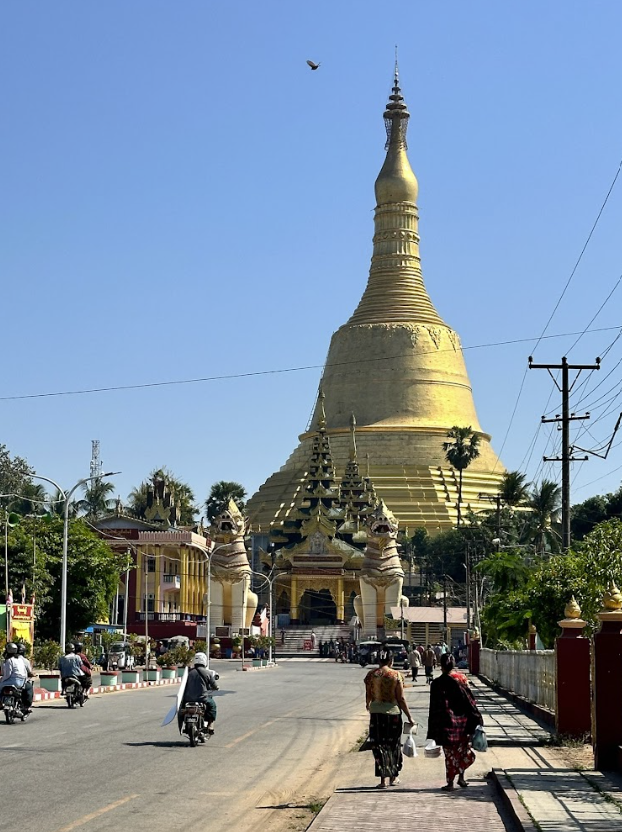
Bagan or Bago City
We head to Bago city (also known as Bagan), a UNESCO heritage site, about 2 hours north of Yangon, by private car
- War cemetery- 27000 allied soldiers named, 6500+ graves out of which ~1000 are Indian soldiers who fought against the Japanese in WW ll. Very moving.
- Shwemawdaw pagoda, the second tallest stupa in the world where the tourist police tried to give us a hard time by asking for our passports and visa number when all this was cleared at the entry. Saw a lot of military personnel with AK47s but they didn’t bother us.
- Shwe thar lyaung reclining gold Buddha (must see – beautiful story of King Migadeepa).
- 4 seated Buddha monument built by the 4 Mon princesses.
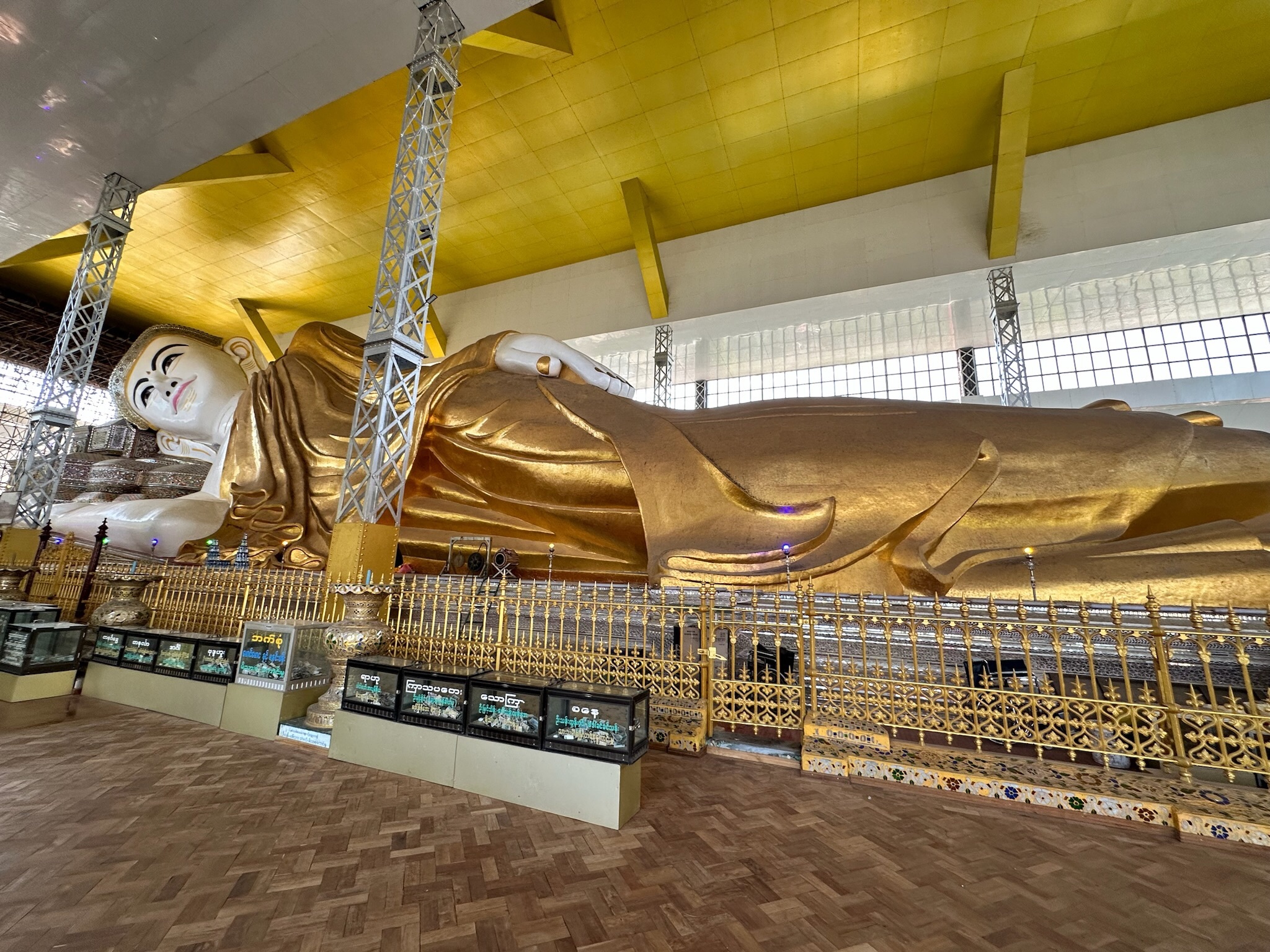
There were middle school girls on a trip to Shwemadau Pagoda in Bago city. Look closely at their cheeks. The Burmese wear a paste called Thanaka on their face made from ground bark/roots of a tree, as sunscreen and to protect from acne. They were happy to take a picture with us. Our tour guide called us the Indian people from Texas.
Also, on this Travels to Savour website, checkout the blog called Myanmar/Burma for more specific information on cities in Myanmar.
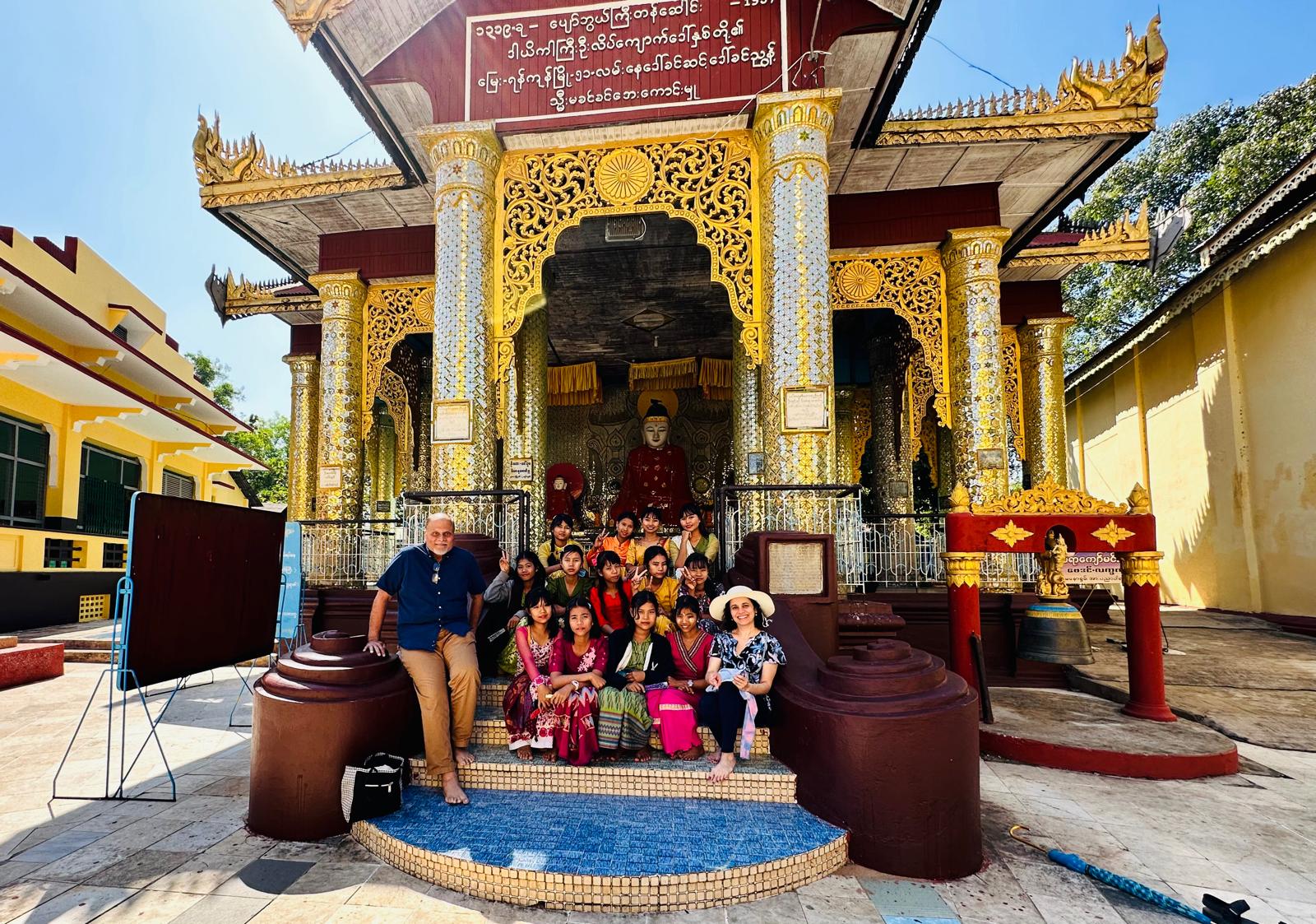
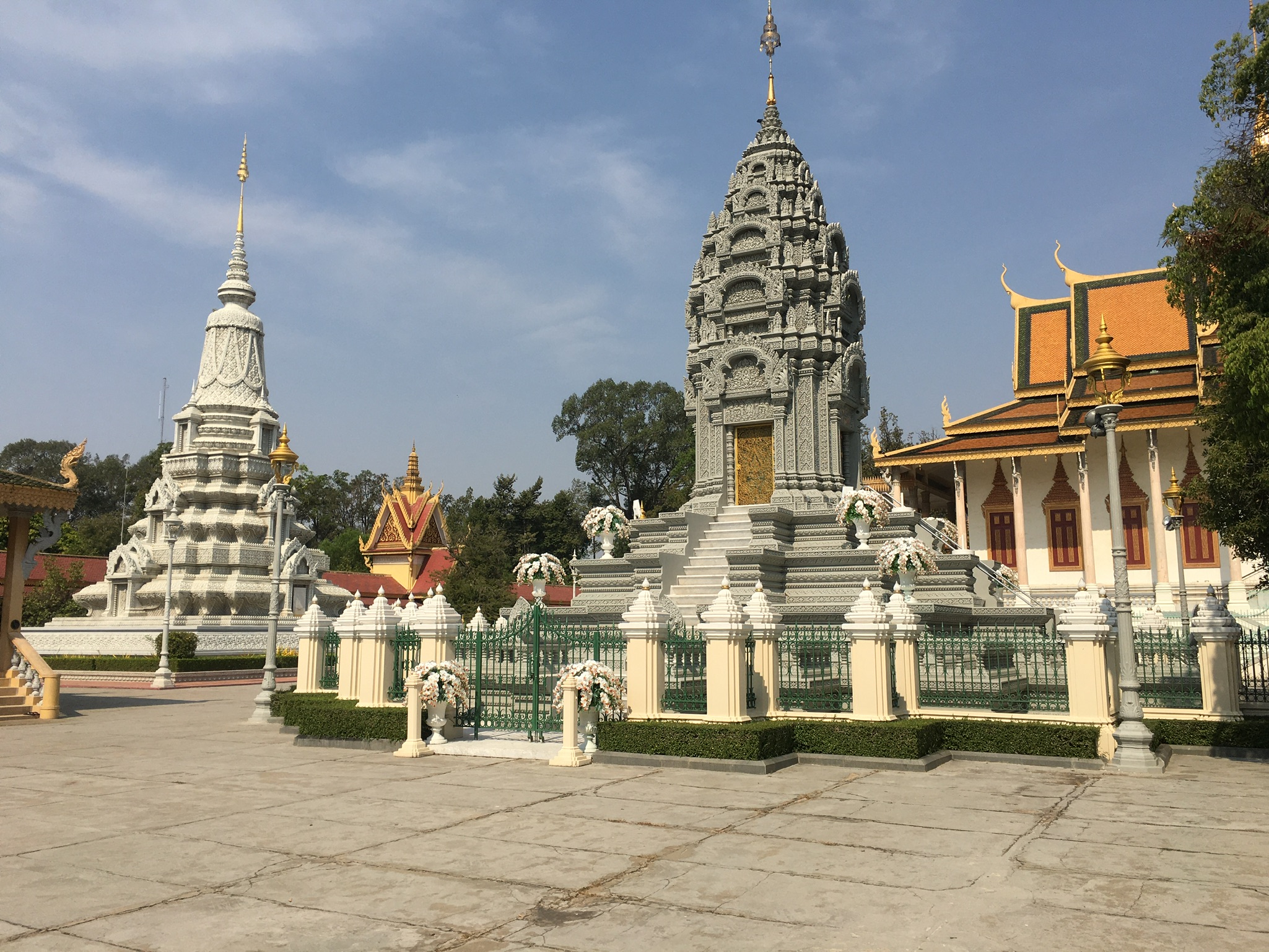
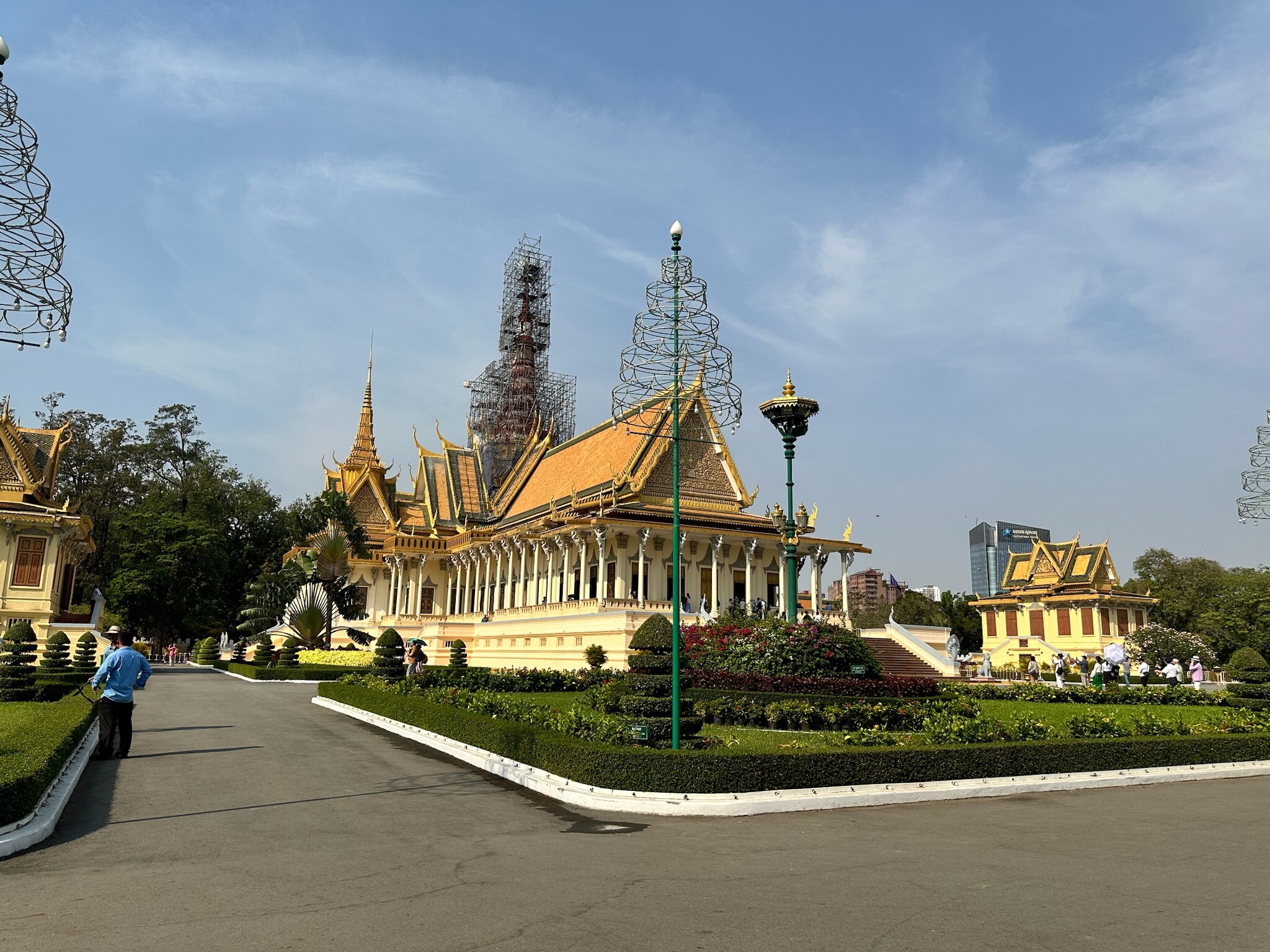
Phnom Penh
- Royal Palace of King Norodum Sihanouk. His son Norodom Sihamoni lives there. Saw the silver Pagoda and frescos of life of Shri Rama. Ramayana is called Reamke in Khmer language and they follow a combination of Hinduism and Buddhism.
- The Nagalinga tree or cannon ball tree that Buddha prayed under.
- Wat Phnom Pagoda located on a hill followed by a stop at the bustling Central Market (open street market with hundreds of vendor stalls selling affordable wares- no relation to our ultra expensive Central Market in Texas). Vendors are selling fake paper money that is made as an offering.
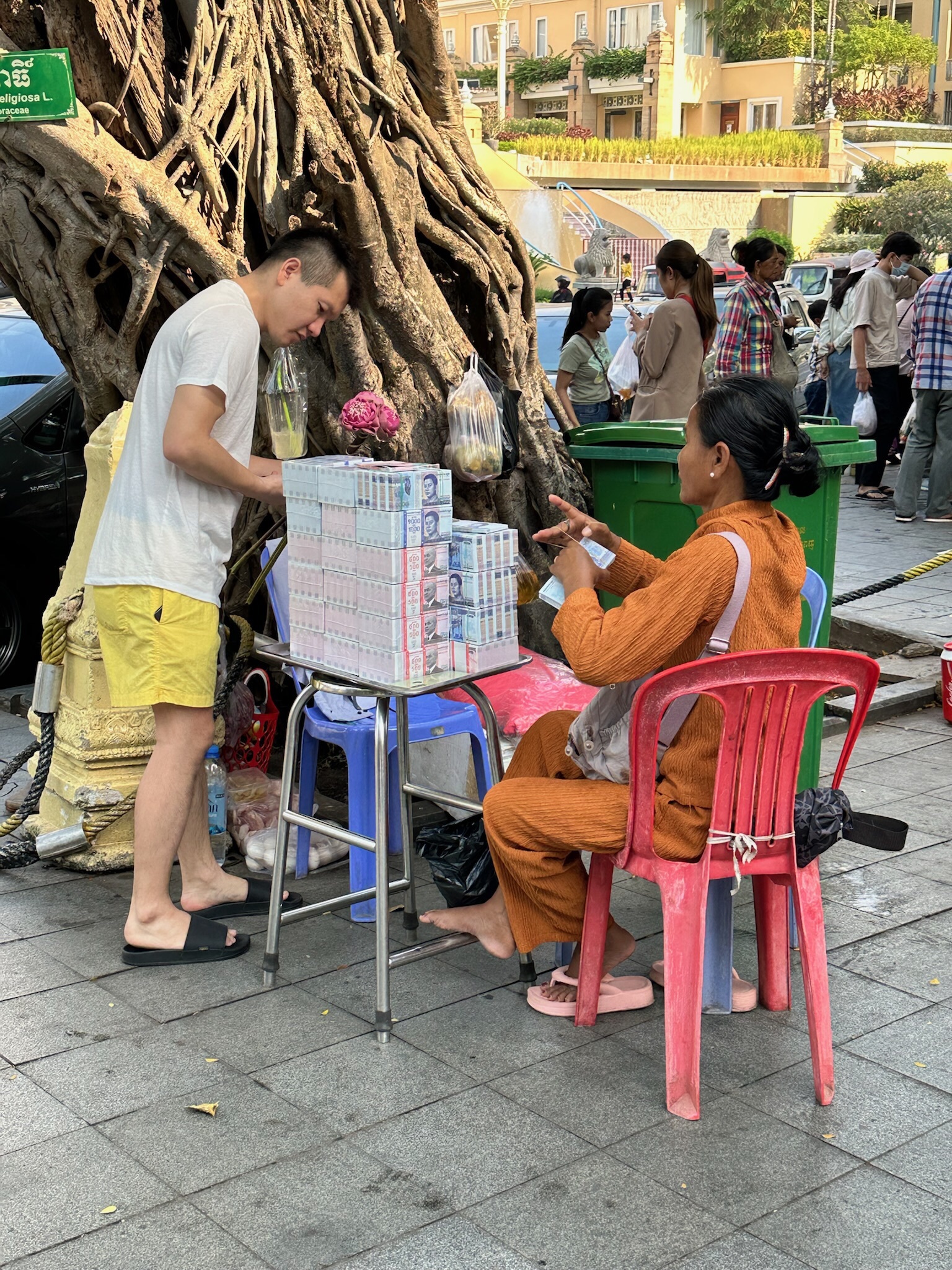
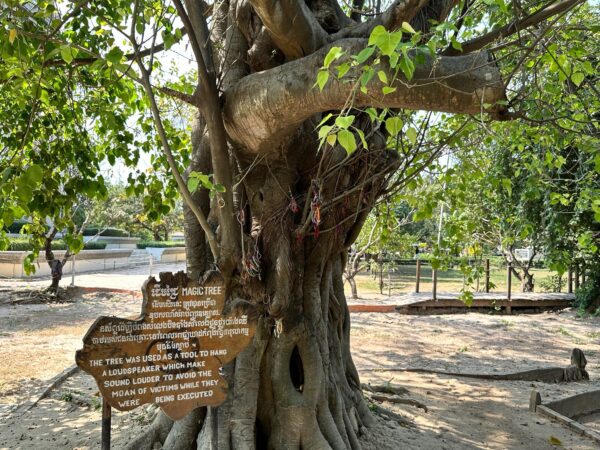
The “Killing fields of Khmer Rouge” and genocide museum. Horrendous atrocities were committed by Pol Pot between 1975-1979 and he killed over 1.7 million people. Felt sad that humans never learn and each generation sees a new version of extreme cruelty. Cambodia was decimated by the tyrannical Khmer Rouge. People died in thousands of starvation. It was sure death or learning to eat whatever was available. Very sad story. But humankind is resilient. Met the 2 men that survived amongst the dead, spared because of their skills. A sobering experience.
The words under this tree sends a chill down the spine.
Siam Reap
The drive from Phnom Penh to Siam Reap takes 5 hours.
- We see the Kampong Krei Bridge on the road from Phnom Penh to Seam Reap. It used to be the longest stone-arch bridge with several arches. The bridge was built in the 12th century during the reign of King Jayavarman VII.
- We also see the Ton Le Sap lake. Unique floating villages that has been designated as a biosphere reserve by UNESCO.
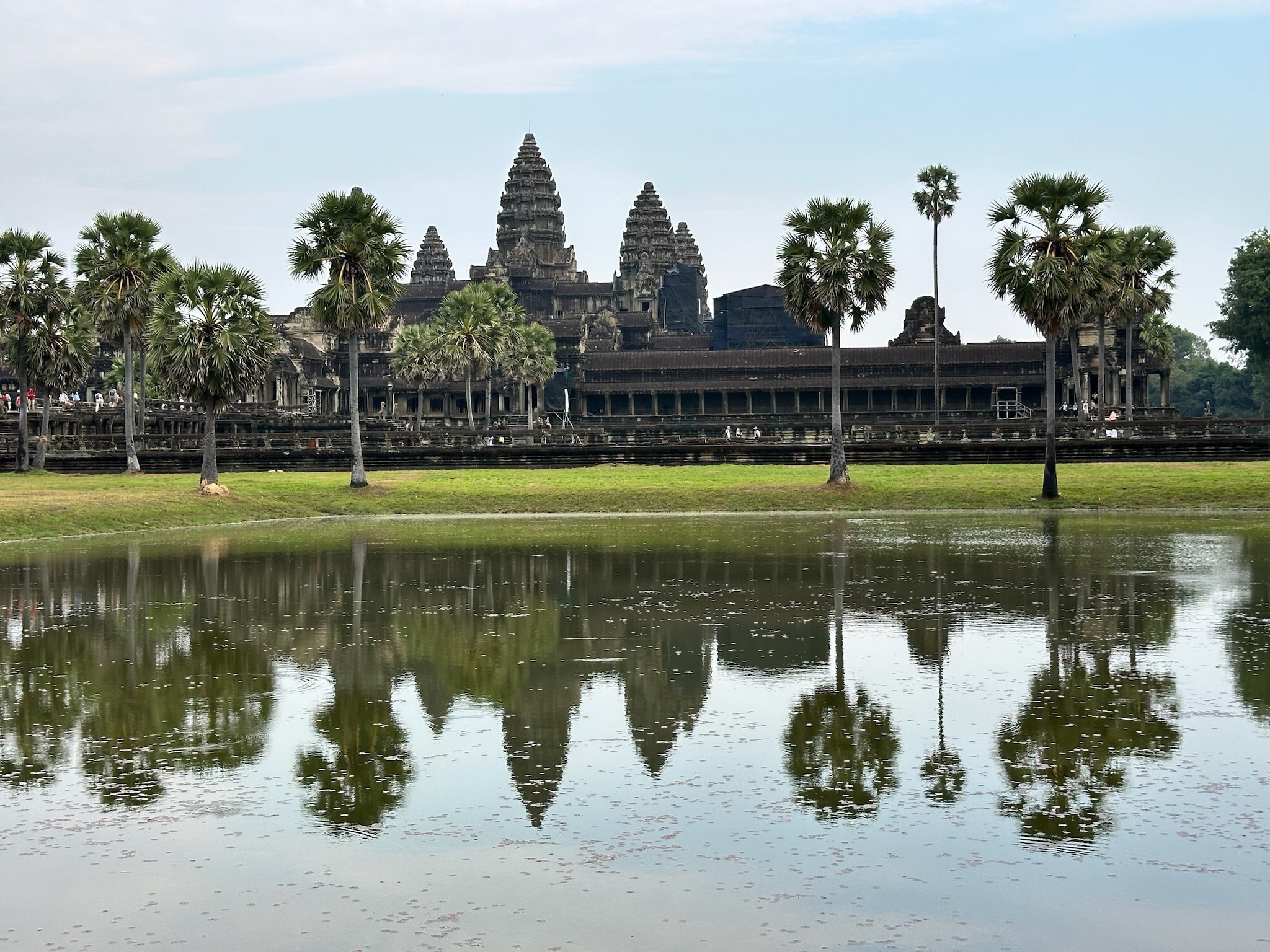
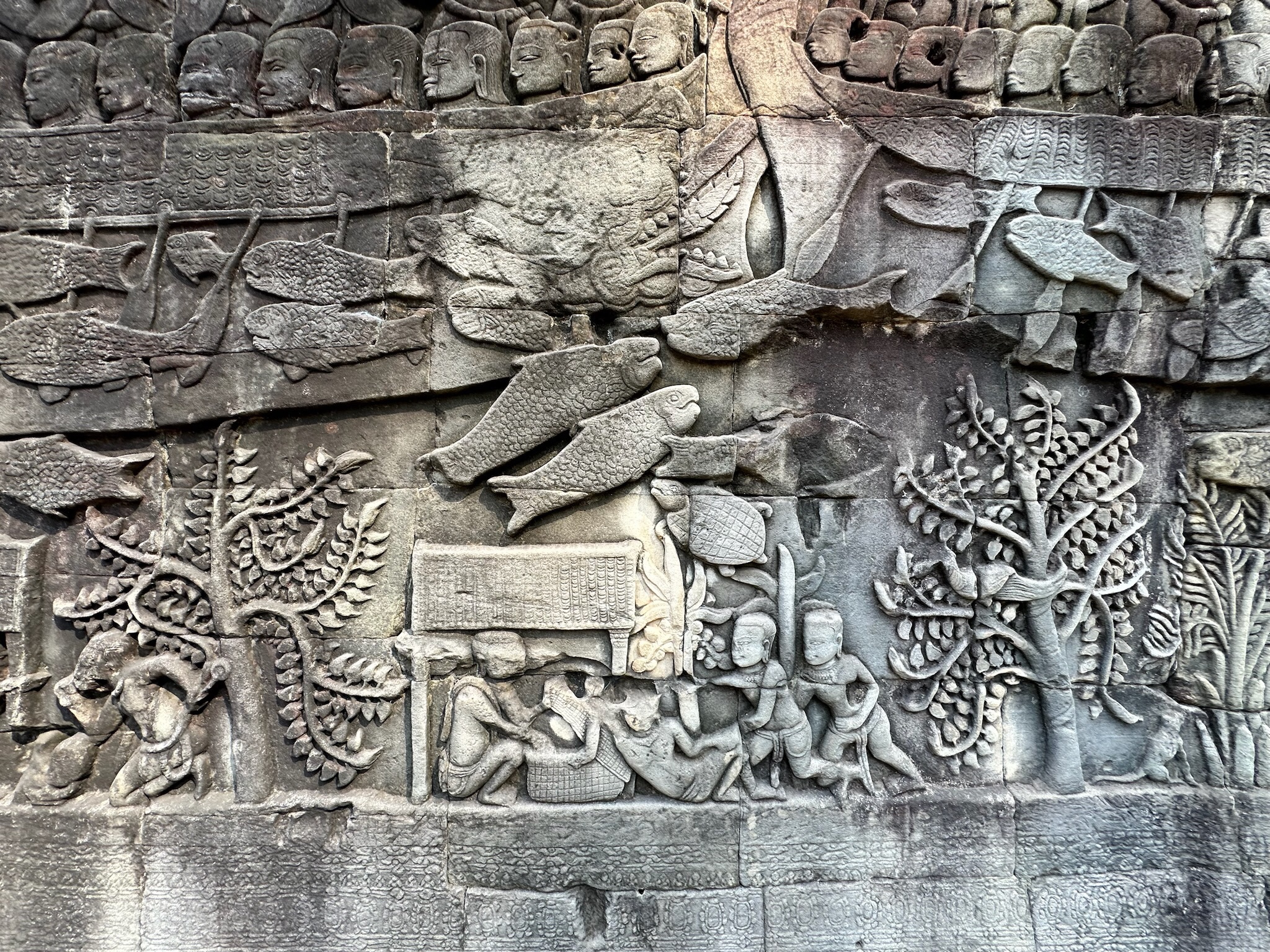
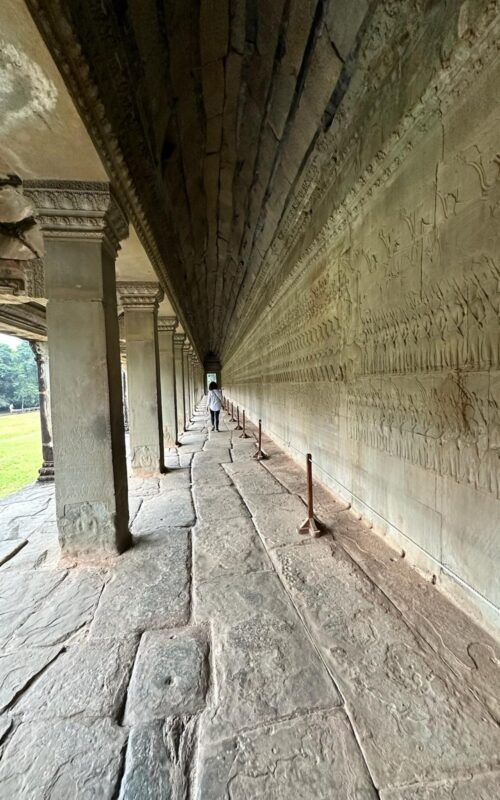
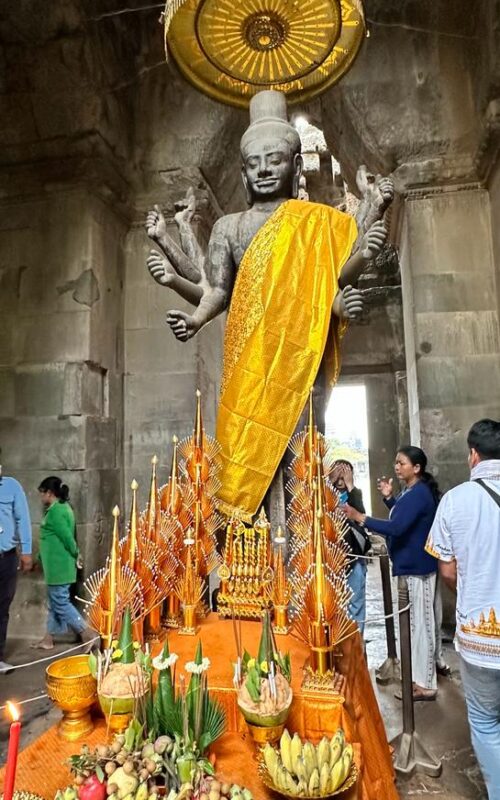
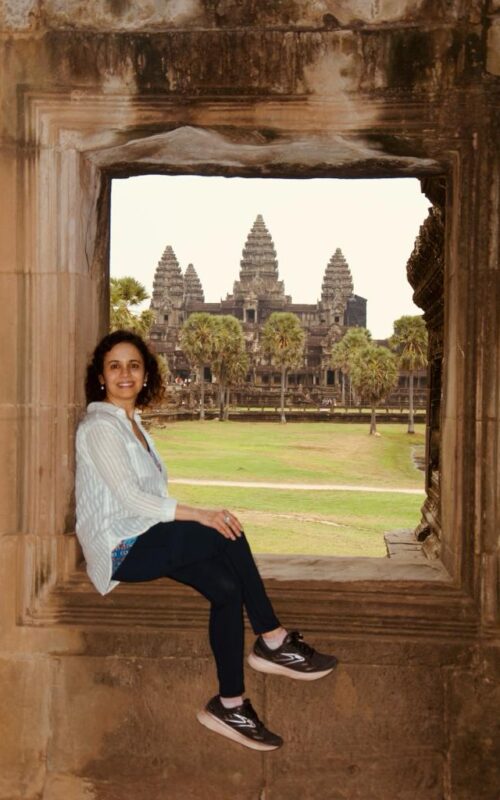
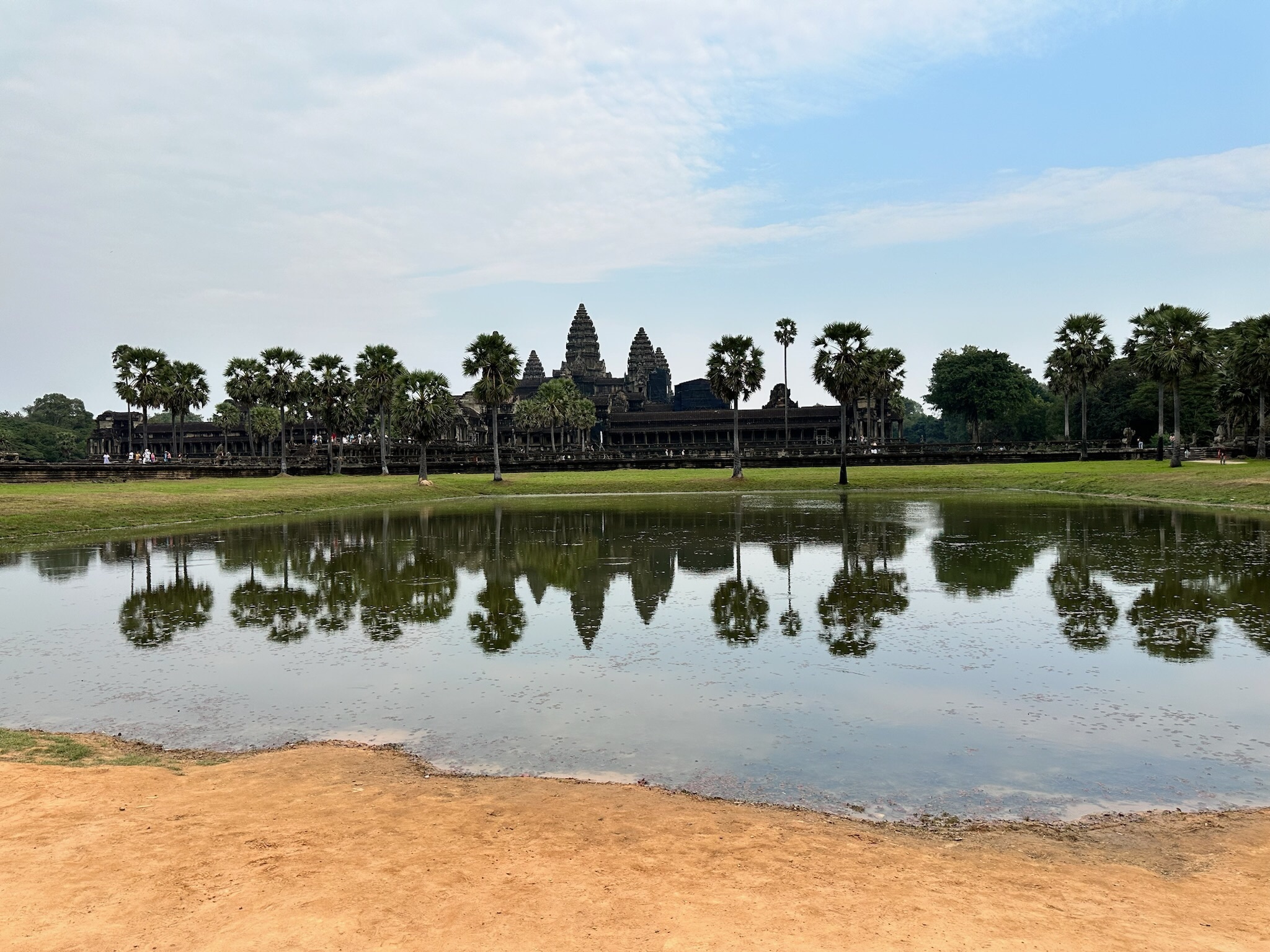
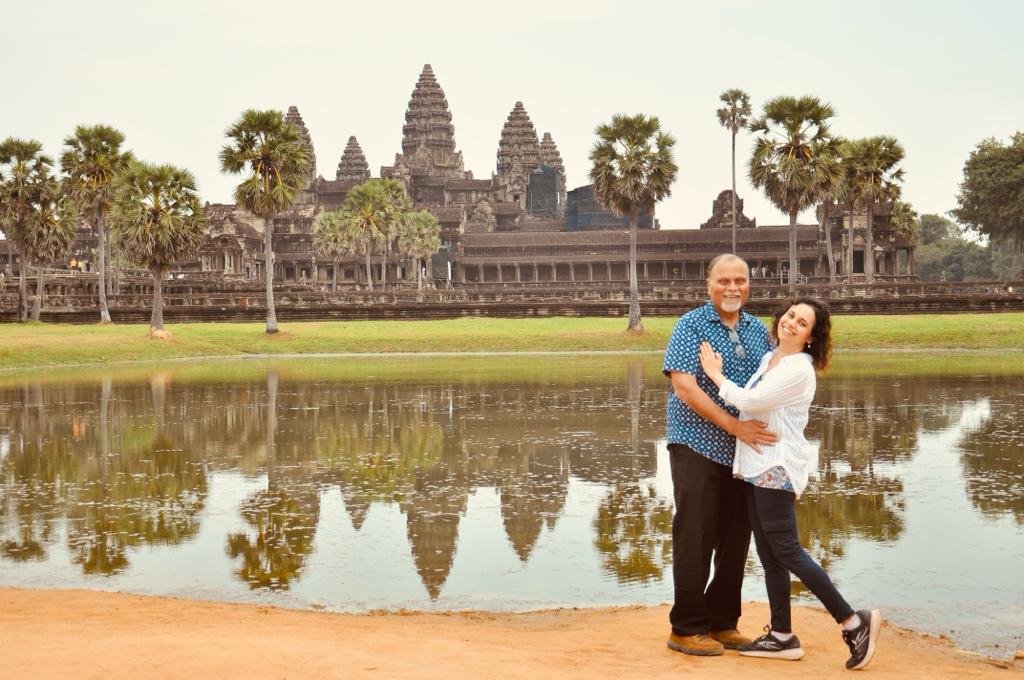
Angkor Wat, the biggest temple complex in the world dedicated to Lord Vishnu.
I have waited for this day since reading about it in middle school. A fun photoshoot at Angkor Wat too. This is truly a spectacular temple which was named “Parama Vishnuloka”after SuryaVarman ll’s cremains were placed in the funerary monument. We climbed up the steep stairs to the sanctum that houses the reclining Buddha statue that replaced Vishnu as the temple deity in the 16th century. The central spire/Gopura represents Mount Meru with 5 total spires on the inside, that show prominently in AW’s representative photographs, and the perfect reflection in the water. It’s one of the wonders of this world! The top Buddha statue replaced Vishnu at the sanctum sanctorum after the Hindu king Jayavarman Vll passed, and the kingdom fell into the hands of Siam (present day Thailand) and Champa (present day Vietnam) rulers. Wish they could’ve coexisted. Regardless they are both beautiful. Ramayana and Mahabharata bas reliefs abound in the temple. Amazing intricacy. Lord Vishnu standing on the tortoise the churning of the ocean by the Devas and the Asuras etc.
- Watched an Apsara Dance Dinner show with very nice dances and delicious Asian foods/desserts!
Angkor Thom
Spectacular! Originally called Jaya Giri (the victory mountain), Angkor Thom was misnamed by the French. Angkor comes from the Sanskrit word Nagara meaning city, which became Nago in Khmer. The French colonists misheard Nago as Angkor and the name stuck!! Thom means GREAT. This great city was built by JayaVarman Vll, nephew of SuryaVarman ll of the Angkor Wat fame. The Bayon temple stands in the center of Angkor Thom. People see the faces of Brahma carved into the face of the king and others believe it is a representation of Buddha.
South Gate with Devas and Asuras on opposite sides is the best entry point. Other sites of interest include Baphoun temple (Ba= Father and Phoun=Hidden) dedicated to Lord Shiva, Royal palace housed in Parama Rajya, Pimean Akasa (temple in the sky), Leper king terrace – Yama statue where king was cremated on a pyre and Elephant terrace.
Jaya Varman Vll was the greatest King of Kampuchea/ Khmer dynasty. He was a Hindu who married his Buddhist teacher’s daughter and adopted both religions as equal. Therefore, at Bayon (originally BANYON) temple, there are 4 entrances- one each for the King (who’s considered the son of God), Vishnu the Preserver, Shiva the annihilator and one for the Buddha. When the generous King Jayavarman VII was succeeded by Jayavarman VIII, Hinduism made a resurgence and fanatics removed all the Buddha statues from the temple leaving large gouged out empty spaces. Subsequently, Buddhists returned to power when Siam (Thailand) seized the Cambodian kingdom, and Vishnu and Shiva were relegated to a lower rank.
It’s awful that people have to create trouble for each other when none exists. Living peaceably didn’t happen centuries ago and mankind never seems to learn. History keeps repeating itself with repeated cultural vandalism. Fortunately, Brahma the creator is recognized by Buddhists and Hindus as a neutral figure. His face lines the lotus brimmed towers (Gopurams) of the Bayon and continues to smile down benignly at visitors!!! And the best part is, both Hindus and Buddhists appreciated the beauty, grace and strength of the Apsaras, who they believe are incarnations of Goddess Lakshmi. Therefore, there are thousands of Apsaras carved into temple walls and not a single one has been deliberately vandalized!!!
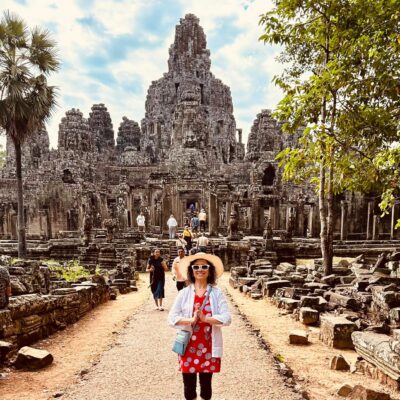
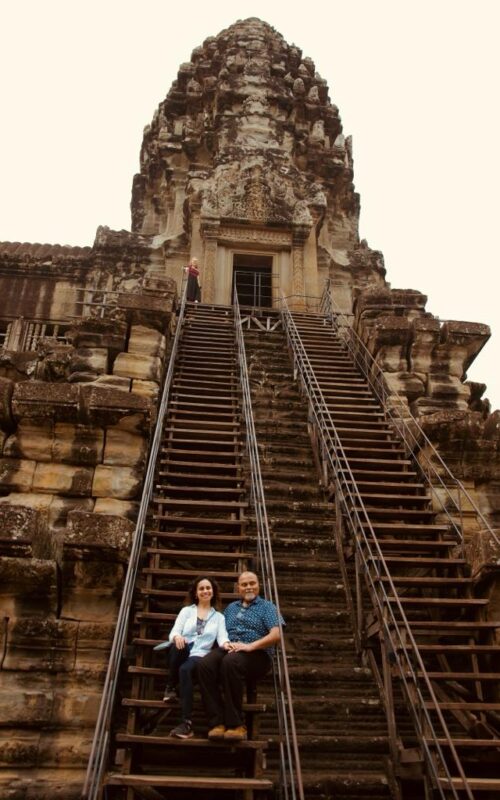
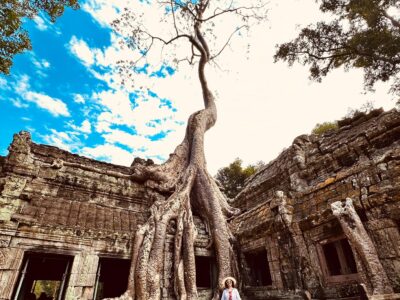
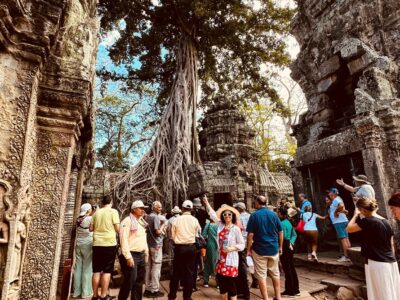
- Ta Prohm (Ta is Grandfather and Phrom is Brahma) temple built by JayaVarman Vll as a gift for his mother. Unfortunately, it was abandoned after the dynasty ended in the 15th century. It was undiscovered for another couple of hundred years. This is a must-see, mysterious looking jungle/tree overrun by silk, cotton and fig trees that have grown between stone masonary and the trunks strangling the temple walls. This has kept growing through times, regardless of warms fought and many changes in the country. This place, especially three massive trees, was made famous after the Hollywood movie, Tomb Raider, starring Angelina Jolie, and it brings in millions of visitors each other!
- PreRup temple (one of the first made with brick not stone)
- Banteay Samre – beautiful bas reliefs of Ramayana and especially Hanuman.
- Walked up the Bakheng mountain to see the sunset at the temple on the top and gaze down to see the sun rays glinting off the walls of Angkor Wat. It’s a steep climb to the temple top. The gold Shiva Linga was vandalized but some stone ones remain.
- Tasted a hot Palm Cake (filled with coconut cream).
- Tried Cambodian coffee at Pople cafe.
- Phnom Kulen (mountain of the lychees) followed by the river of the thousand Lingas. Amazing sights!
A day for Shiva Darshan. Nowhere in the world are you likely to see over 1000 Lingas in a river bed. In 802 AD, King Jaya Varman ll had this river diverted to have the thousand and a reclining Vishnu with Brahma sprouting out of his navel, carved. Context- Shiva was considered a “hot” God who needed to cool off after dancing the Thandava. Hence, the reason for carving him into the river. It is possible to spot the face of Vishnu and some of the Lingas under the running water.
- Banteay Srei
An exquisite Temple north of Siem Reap called Banteay Srei – meaning Citadel of Beauty/ Fortress of Women (like our Indian Sree) – it’s a miniature temple compared to the massive Angkor Wat and built over 1000 years ago by King Rajendra Varman’s Guru, Yajna Varaha who was an ardent devotee of Lord Shiva. But he wanted to be impartial to the Hindu Gods!! Hence, carved lintels of Rama, Krishna, Hanuman, Shiva and Parvathi in rare pink Sandstone adorn the towers. Tribhuvana Maheshwara is the main deity! My favorite lintel is of the playful Little Krishna and his older brother Balaram depicted as cowherds with Lord Indra looking downstairs from his elephant mount Iravat (called Erawan in Khmer). Looks like Indra was trying to rain down on the party and Lord Krishna asked him to save his thunder upstairs until the cows were done eating lunch!! I’m having fun reimagining the story that gave so much joy in childhood! Look closely at the picture- you’ll find all the Gods mentioned and the cowherds too. The wheel of Krishna’s chariot is broken. The temple is over 1000 years old after all……
This temple was not on our initial itinerary but upon request, our guide took us there. Rough gravel road but totally worth it.
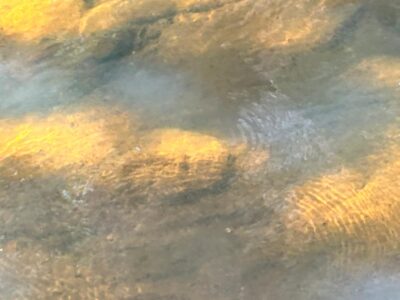
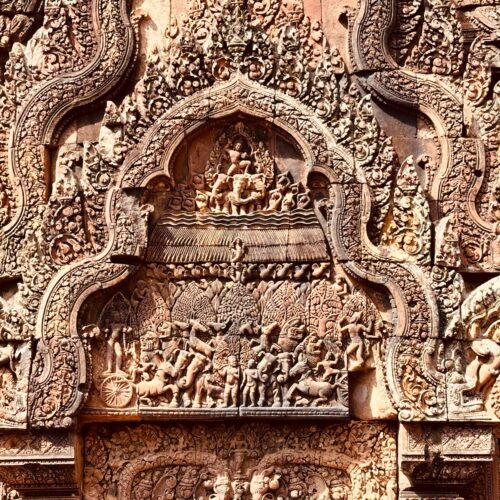
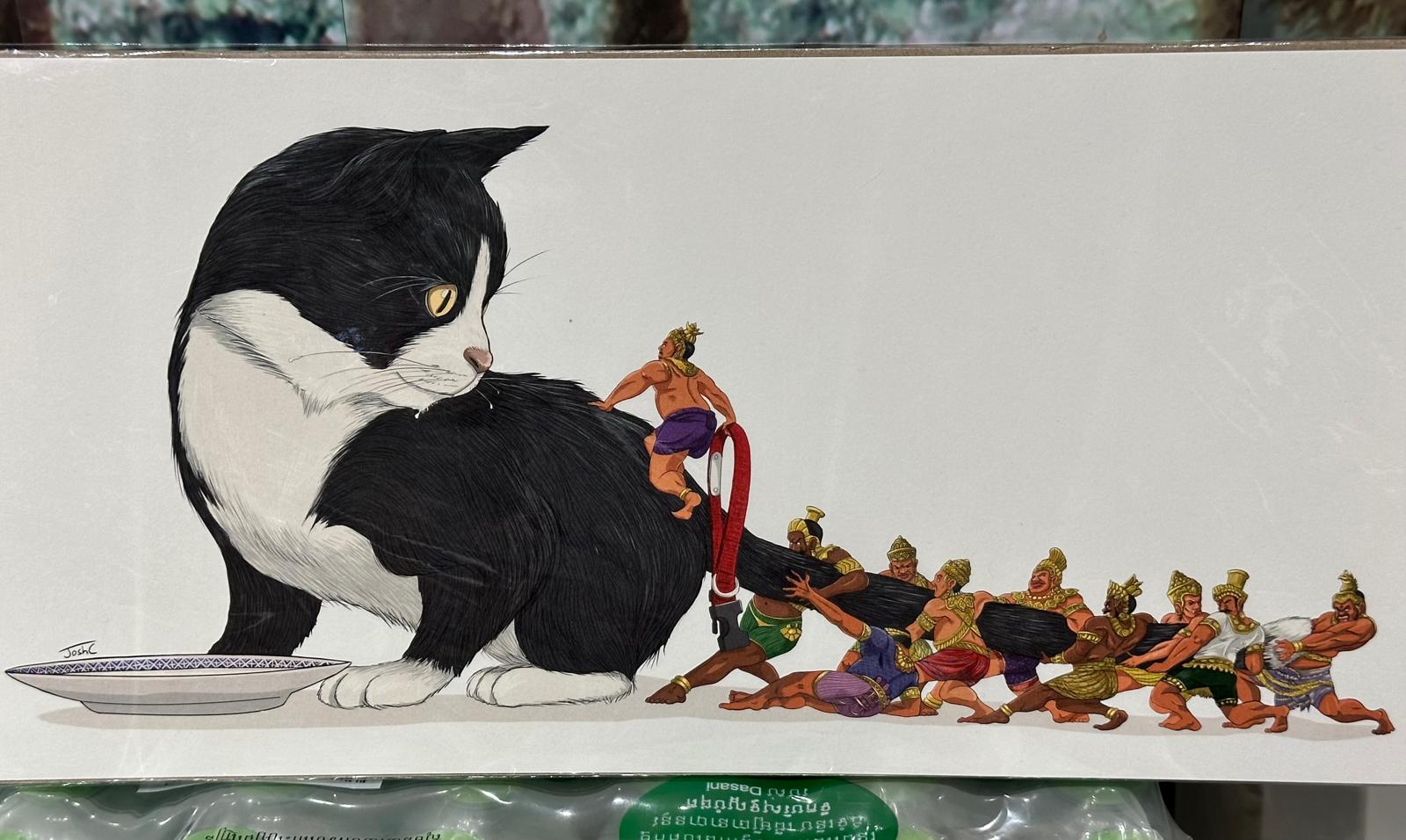
Cats of Cambodia!
The cat plays a very important role in Cambodian life and is a symbol of good fortune. For example, to bring good luck to a new house, the mistress of the dwelling needs to walk around it 3 times carrying a female cat in her arms. Like our Pradakshine in Hindu temples. At the end of a dry season, the entire village will hold a procession with a cat praying for rain. The cat will be brought to the front of every home and water is sprinkled on it. Does this remind you of an Indian tradition of sprinkling water for purification?! Cats were even used in coronation ceremonies of kings of yesteryears!! They were an exalted beast just like their cousin the Tiger. Our guide in Cambodia was very enthusiastic is telling us these stories! Apparently, they continue to have the tradition at housewarming ceremonies.
LAOS
Luang Prabang, Kingdom of the Prabhang Buddha
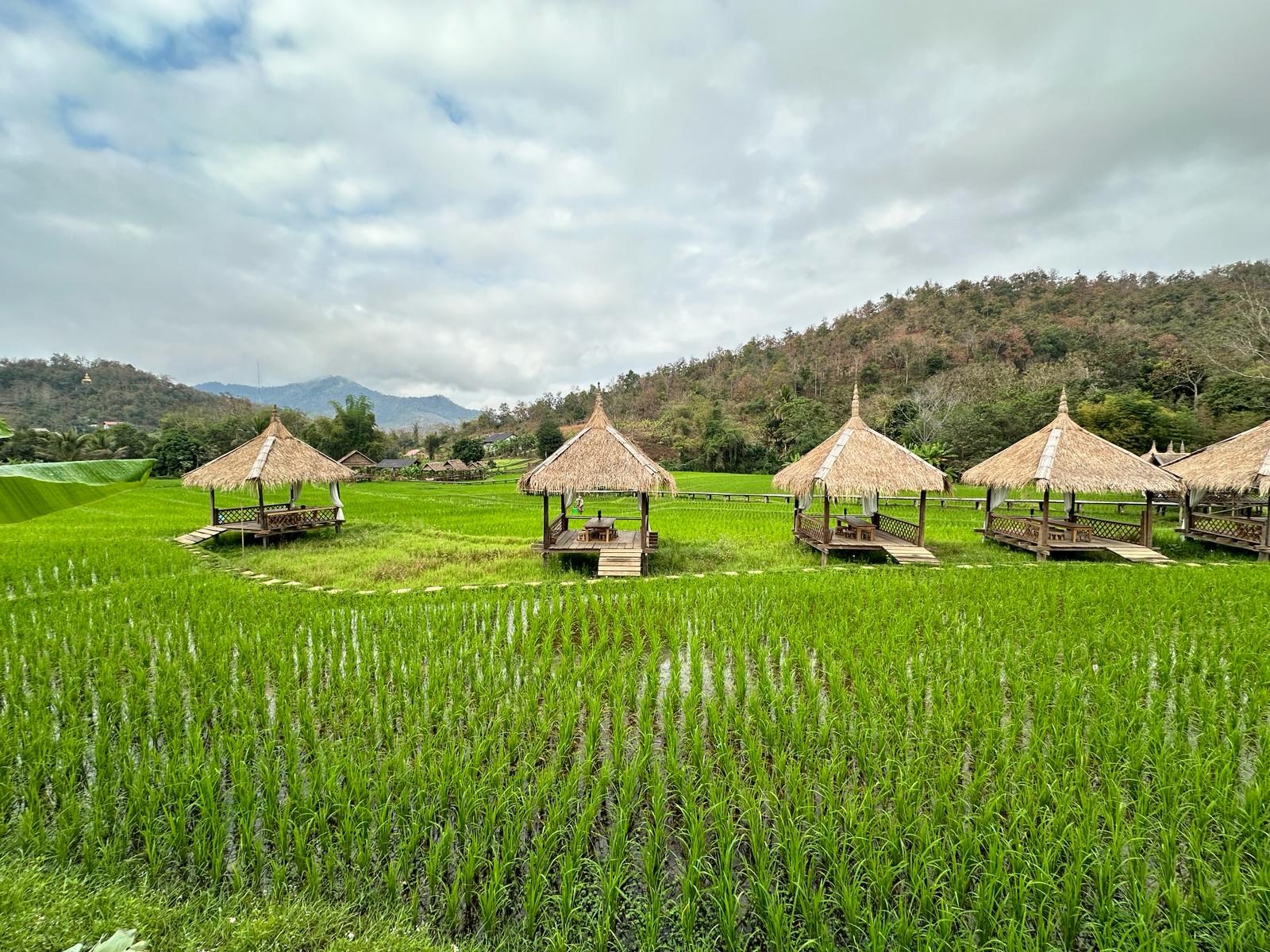
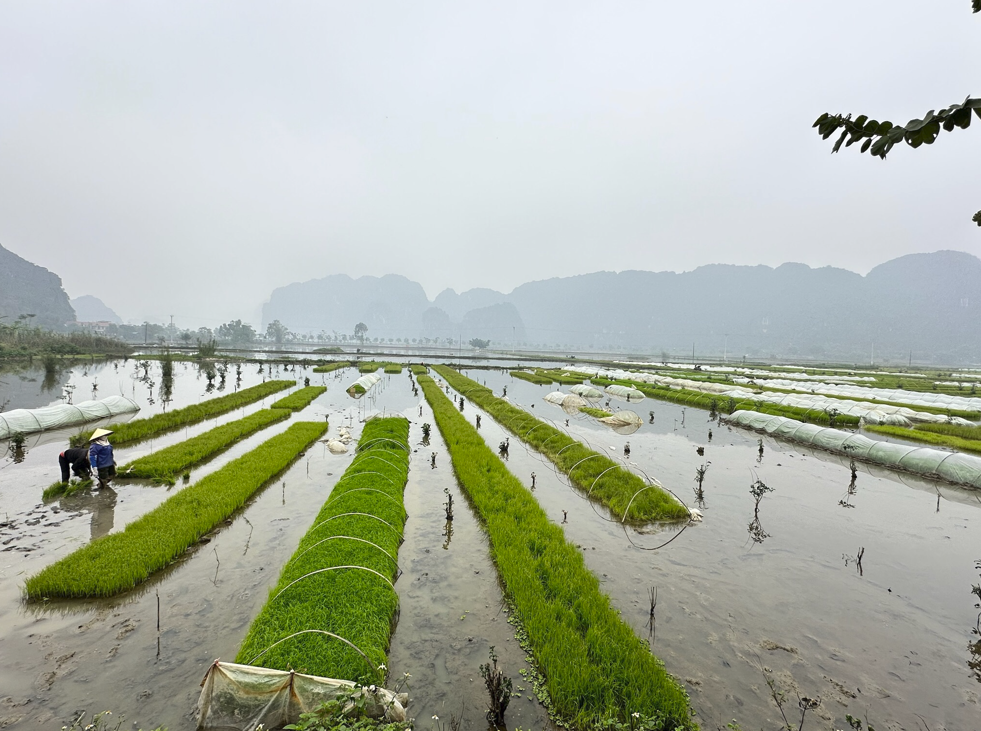
- A Motor Boat ride on the mighty Mekong from Luang Prabhang city to the Pak Ou caves crammed with 4500 Buddha statues brought by devout villagers. Be prepared to climb up some steep mountain stairs!! Mekong originates in Tibet and goes through Tibet, China, Myanmar, Laos, Cambodia, and Vietnam. After sweltering in the Cambodian 90° heat, the cool 60° temperatures in Laos are such a welcome change!
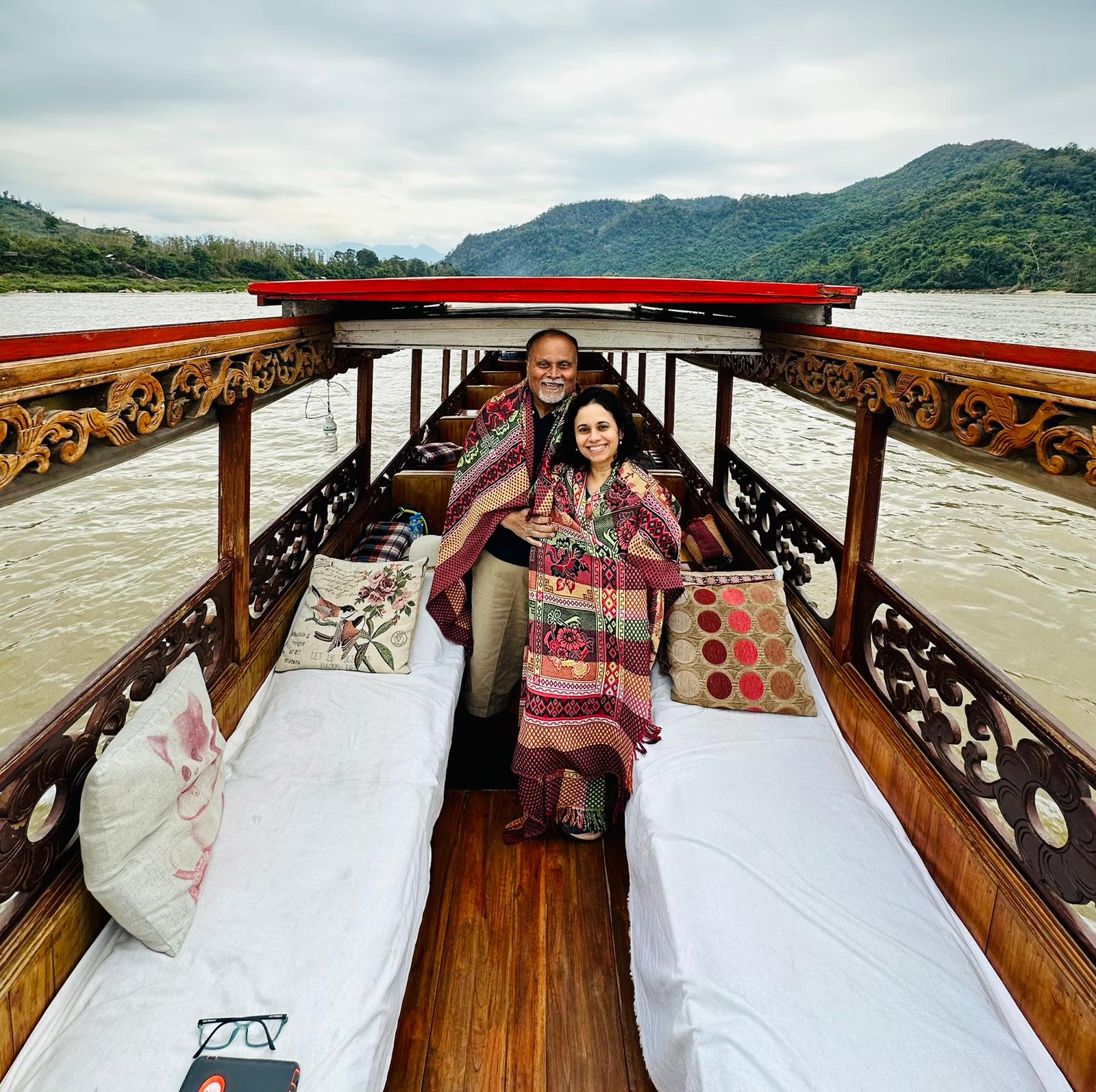
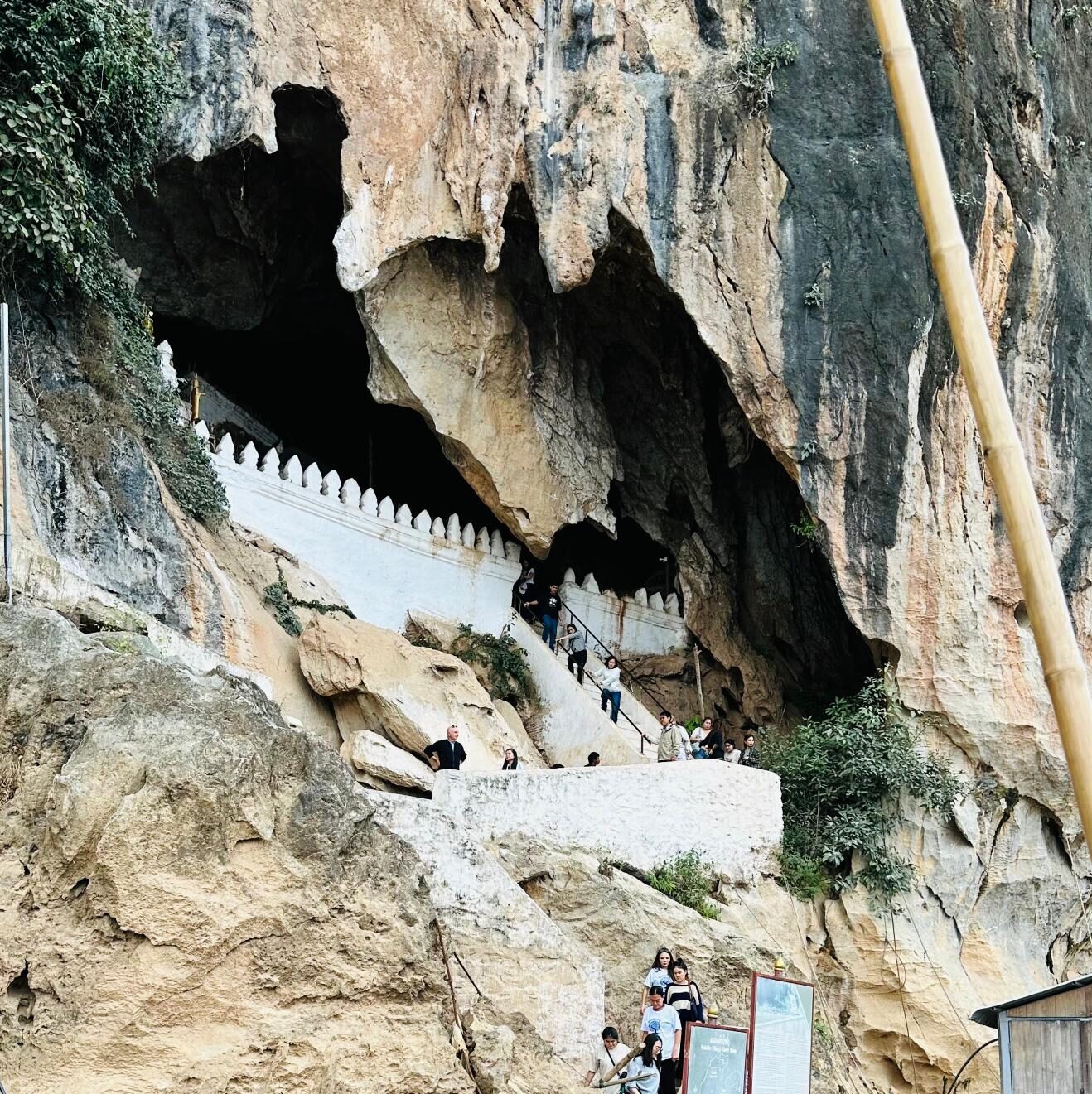
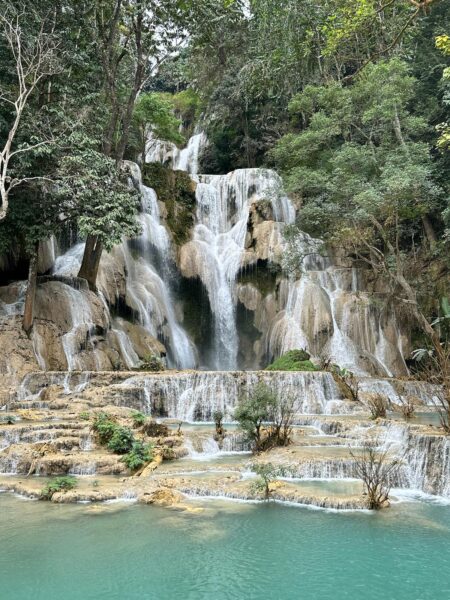
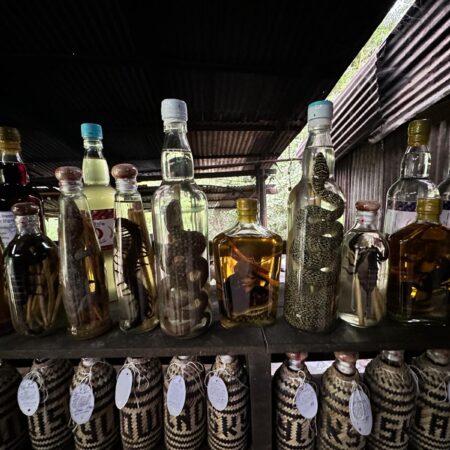
Luang Prabang tour
- Stroll down the unique central market.
- Pagoda of the iconic 2100 year-old Luang Prabhang Golden Buddha from the 1st century brought from Sri Lanka, then tour the national museum previously the royal palace of King SisaVang Vong and son SisaVang Vattana (he disappeared in 1975 and nobody knows exactly how he and Queen Khamphouy died).
- The magnificent Wat Xieng Thong, at the confluence of Mekong and Nam Khan rivers, housing the Kings funeral carriage (the Ramayana scene with Sita’s Agni Pariksha is remarkable).
- We ate at this famous Laos restaurant called Tamarind.
- Mount Phousi where 2 hermits who were brothers inspired a Stupa.
- Night Market with handicrafts.
- Khouangsi waterfall hike on forest trails -a MUST See. Incredibly beautiful waterscape straight out of a picture postcard.
- Cute little Ethnic Hmong Village is a tribal exhibition that displays textiles and embroidery.
- Way Aham, Wat Visoun (oldest temple) and Wat Sen Soukharam were other temples we saw.
- Lastly, how can we miss showing the various creepy crawlies and snakes in bottles of drinks?
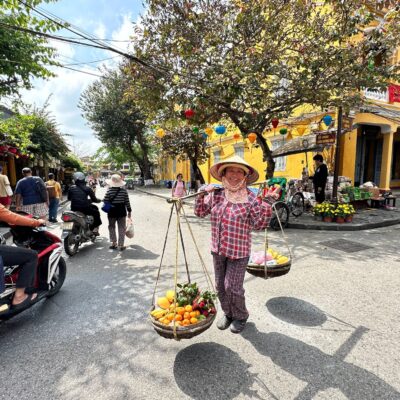
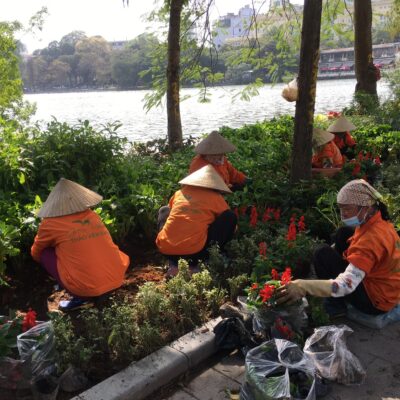
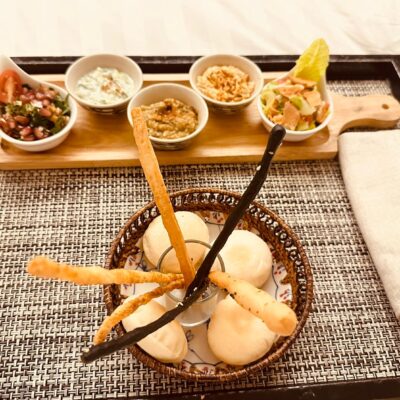
Hanoi city tour
- Ho Chi Minh presidential office, stilted house, mausoleum, lake surrounded by Mangrove and pomelo trees. The Presidential Palace of Hanoi was originally intended to be Ho Chi Minh’s official residence. At present, tourists are not allowed to enter the interiors of the building.
- One Pillar Pagoda (representing the lotus on a single stalk- pure and minimalistic) built by a king in gratitude for the birth of a male heir.
- Temple of Literature- the largest ancient university in Vietnam which graduated over 2300 mandarins (learned men who had to take rigorous studies and exams to attain coveted status in the king’s advisory board). Confucius is worshipped in the sanctum and the drum used in place of the modern school bell is intact! Interestingly the commonest surname here is Nguyen and they are descendants of the last monarchy of the same name (some of the other dynasties were Le, Tran, Trung etc).
- At the heart of Hanoi, the Lake of the restored Sword aka Hoàn Kiem Lake. Hoan Kiem Lake story is one of the most famous folktales in Vietnamese culture that is about a sword being given to the king by a turtle in this lake which helped him win over the Ming forces. The turtle is revered. The iconic Red Huc Bridge is located here.
- Indulge in the uniquely Vietnamese egg coffee (worth trying once).
- Watch a Water Puppet show- a traditional art form that began over 1000 years ago in the Red River Valley when it flooded (the modern show happens in a large water tank) – A must-do. It was so fun and the best part of our day.
It takes 2.5 to 3 hours by road to get from Hanoi to the next likely stop, Halong Bay. Checkout various travel options here.
Hạ Long Bay
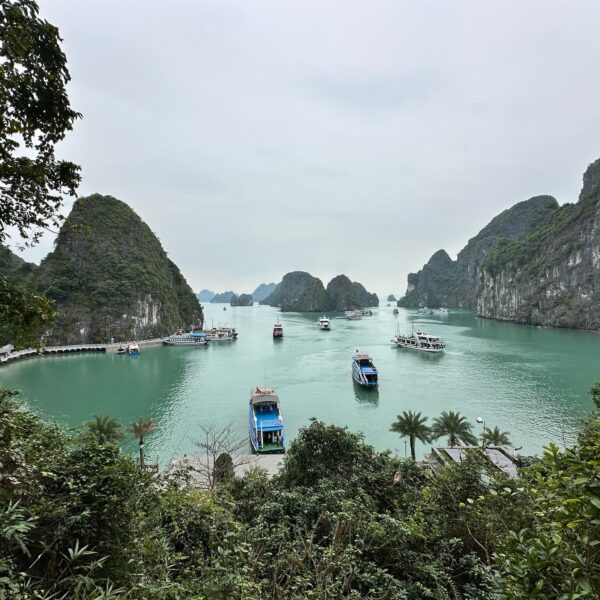
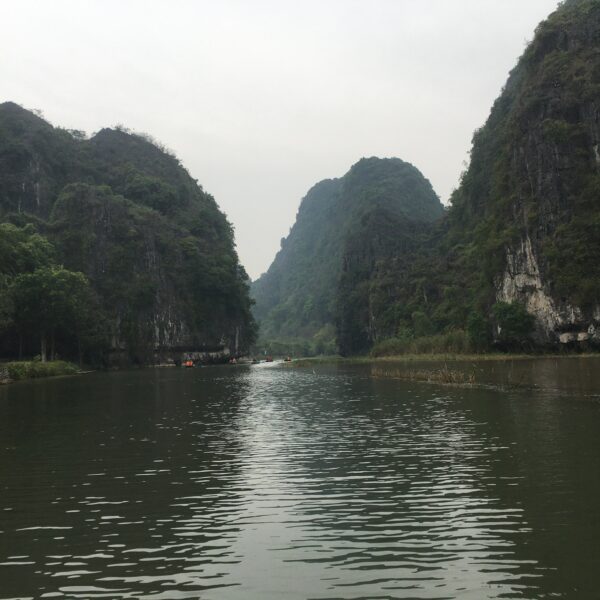
- Hạ Long Bay or Halong Bay is a UNESCO World Heritage Site that is one of the most beautiful places with its mystical limestone islands and emerald blue waters.
- If you have a night, spend it on a boat in the bay as overnight cruises are available. We did the all-day one (Ambassador cruise lines). Ha Long Bay is the Bay of the Descending Dragon. Legend has it that a dragon mom and her children descended from heaven, to defend the Vietnamese people from invaders, spraying fire and emerald and jade. The jewels formed the 1,969 limestone islets jutting up from pristine water of the most intense bluish-green hues!!
- The cruise line can be taken to Sun Sot cave, Titov island and Luon cave kayaking. Simply glorious creation of Mother Nature!
- Hang Sun Sot, Cave of Amazing Surprises, houses some stunning thousand-year-old uniquely shaped stalactites and stalagmites. Dragons and turtles and elephants and lions, including one shaped like Romeo and Juliet!
- Titov island- A crescent, moon shaped beach, and a 844-stair up and down climb, to take in the breathtaking 360° view of the bay. Worth the exercise!
- Luon cave kayaking or bamboo boat ride, a cooking class, making Vietnamese style empanadas on the cruise ship.
- Tour the Legend Pearl Farm in Halong Bay: The Tung Sau Pearl Farm lies was established in 1995 through a joint venture between a Vietnamese and Japanese company. This unique pearl farm has become a destination for travelers seeking an immersive experience in the art of pearl cultivation.
Ninh Binh
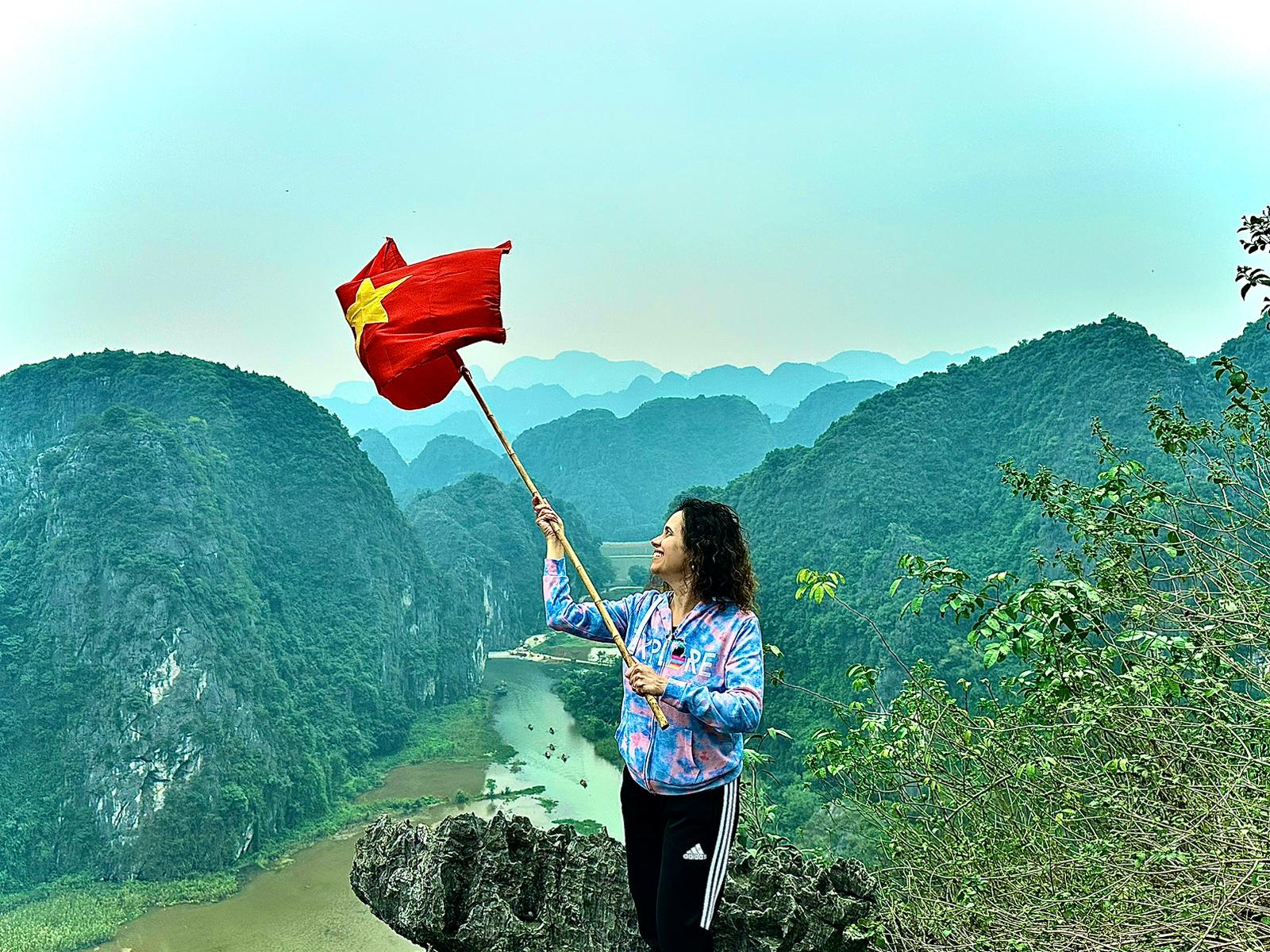
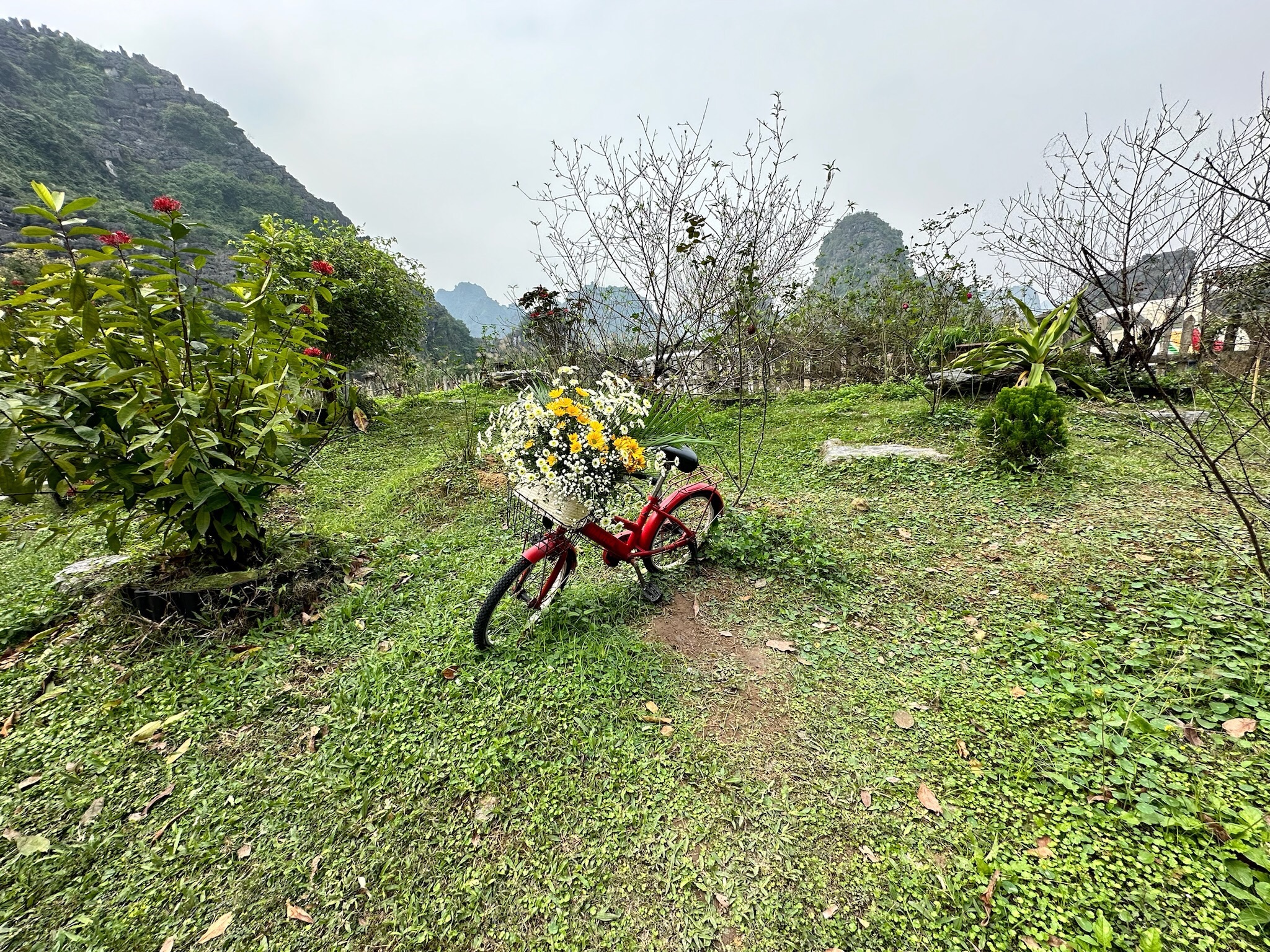
From Halong Bay, one can drive south (3.5 hours) to Ninh Binh or back to Hanoi (1.5 hours).
Ninh Binh means glorious and tranquil.
- Stop at Bamboo superstore to see all products made from bamboo fiber & bamboo charcoal.
- The Hang Mua (Cave of Dancers) is located on a steep limestone mountain in Ninh Binh city, Vietnam. Climb a thousand rugged mountain stairs to the Lying Dragon and Lady Buddha statue. The steps followed by craggy sharp rocks to get to the top made me feel a small % of the adrenaline that fearless mountaineers probably feel!! If you make it, you get to hoist up the Vietnamese flag at the top!! It was not easy at all and slippery in some spots.
- A scenic boat ride to Tam Coc grottoes, down a massive winding stream – watch the boat ladies row with their feet! So, what’s unique? These boats are almost all “manned” by Vietnamese women. And they use their legs, not arms to row!! They are strong and can row continuously for 6-8 hours a day! Our boat woman was over 65 years old but rowed like superwoman. Wait…..there’s more! A paparazzi Boat with a woman photographer comes by to take photos as she’s rowing furiously with her feet!! Two days in Tam Coc, Ninh Benh.
- Explore in and around this beautiful ancient city, much on foot. It was the old capital of Vietnam before Hanoi.
- Nature’s best bicycle ride on serene forest trails of Ninh Binh. Mr. Phong was the best guide!!
We next flew more South to DaNang.
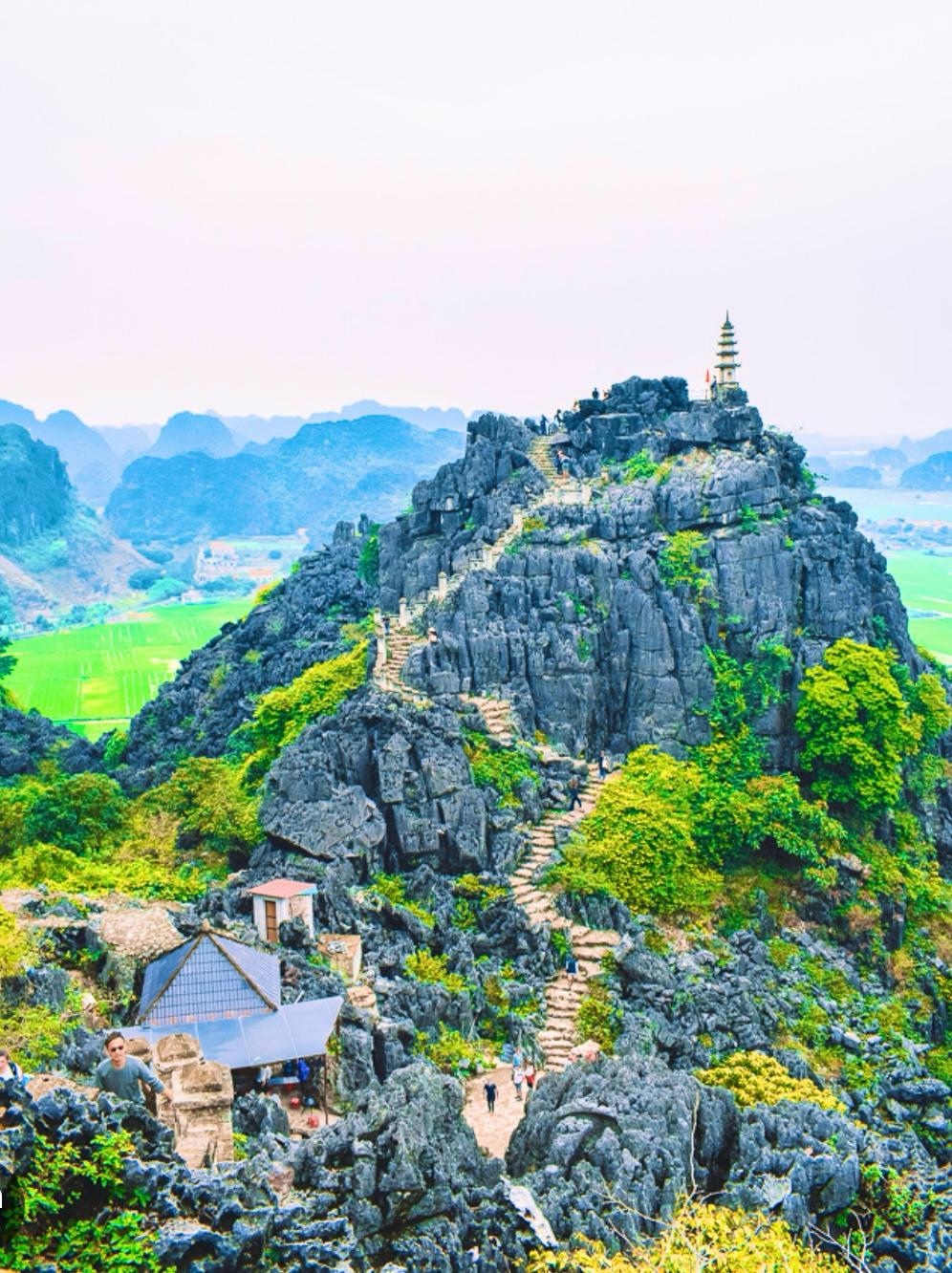
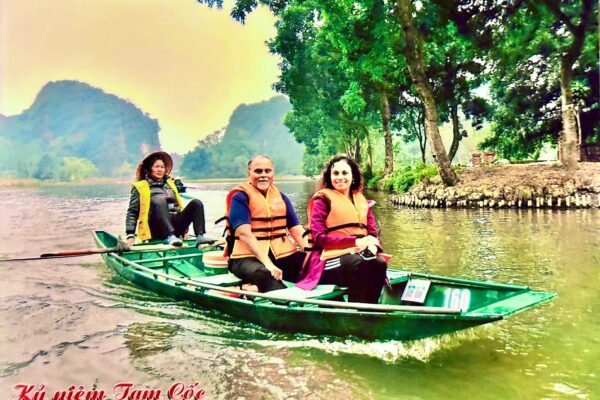
Da Nang
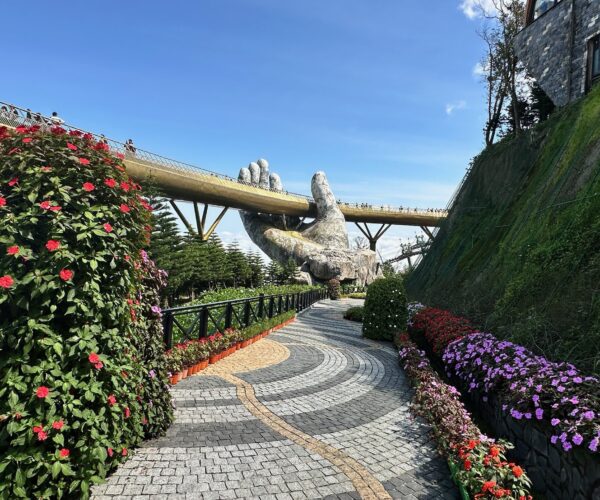
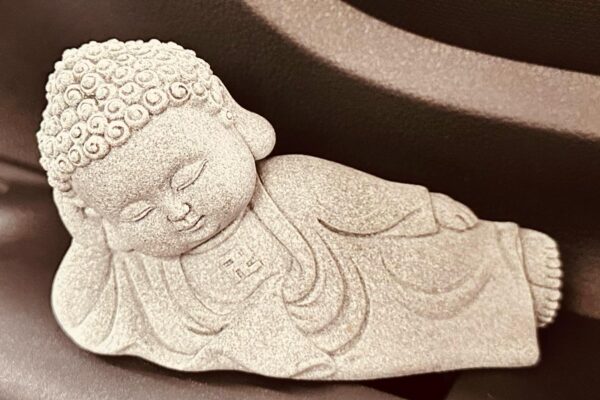
A lovely hill resort that French colonists retreated to in the summer like the British did to Shimla.
Bana Hills – how did this name come about? Is it supposedly named by the French based on “BaNana” trees that abound on hills? BANA meaning “My Mountain” in the native tongue is most likely the source of the name.
- There are Marble mountains (Thuy son) that houses a beautiful Pagoda and an ancient Shiva temple built by Champa kings.
- BaNa Hills with the world’s longest single cable car system. And what’s so special about their Cable car? The Bana Hills Cable Car is an engineering marvel that set the world record in 2013 for the longest non-stop single-track cable car It stretches about 18,930 feet.
It consists of 86 cabins, holding 10 passengers and takes approximately 20 minutes. Simply stunning views of the mountains (Mt Chua) and verdant countryside. The 86 cabins look like hot air balloons floating in the clouds! - A French village with fantasy land rides was fun.
- There was a 182 item extraordinary buffet in BaNa hills.
- The spectacular Golden bridge Cau Vang, held up by massive hands is supposedly the mysterious ‘hands of god’ holding up a gift from the earth.
- A sleepy baby Buddha cast in sandstone in DaNang. Loved the calm and smiling countenance. See Swastika (the symbol of wellbeing and harmony) on his sternum? It’s called Manja in Korean Buddhism and Van in Vietnamese.Makes one upset that Hitler took something so revered and defiled it by making it a Nazi symbol of white supremacy and pure evil. Apparently the right-facing symbol (卐) is called swastika, symbolizing surya (‘sun’), prosperity and good luck, while the left-facing symbol (卍) is called sauvastika, which is visible on the Buddha in Vietnam, Japan and Korea(those practicing Mahayana and not the Theravada school of Buddhism) per our guide. Hopefully most rational people will look beyond Hitler and recognize the beauty of this symbol of goodness.
We next drove to Hoi An, a short 40 minutes away.
Hoi An
Hoi An is a well-preserved ancient town that is a UNESCO heritage site.
- It is a hub for artists, shop for handicrafts, lanterns, and a visit to the silk village and the coconut village is a must!
- Visit good cafe’s.
- There is a Japanese bridge with noteworthy architecture, dating back to the 18th century, and is a tourist attraction.
- Take a sunrise boat ride to fishing village.
- Hoi An tour of old city.
- Mecca of custom-made clothes, shoes and bags. Shop till you drop. Buy an “Au Dai” dress.
- Catch the spectacular Hoi An Memories show!
From Hoi An, back to Danang. We then drove the winding Haivan pass from DaNang to Hue (the capital of “Nguyen” dynasty) that takes about 2 hours.
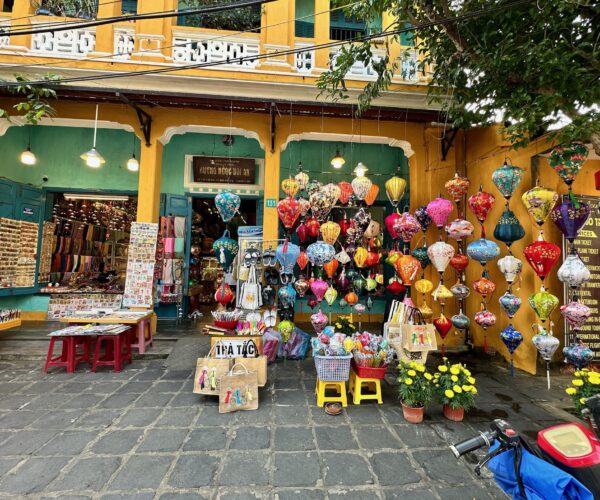
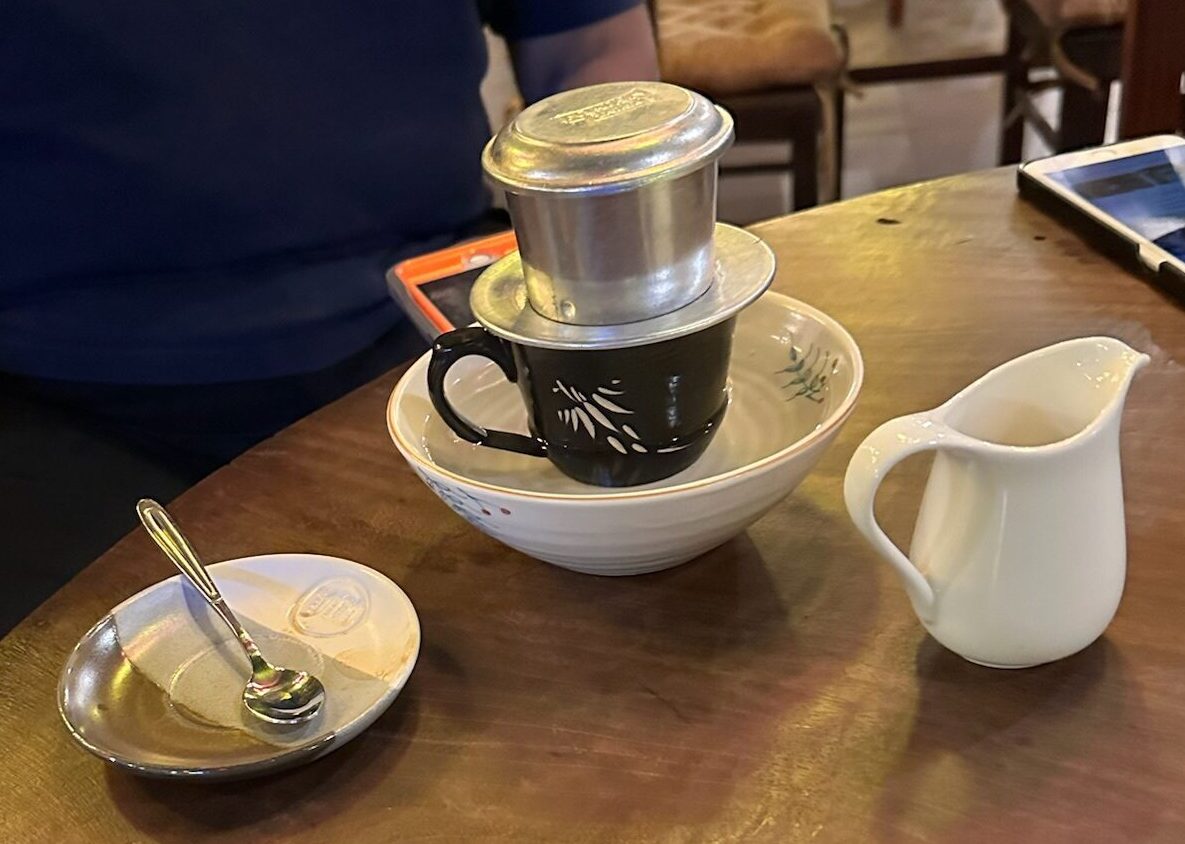
An AU DAI dress
Au Dai (pronounced OuZai) is the national dress of Vietnam.I wa s struck by the similarities to our Indian Salwar Kameez. The long pants are a bit looser, almost like Palazzos. And the Kameez is ankle length, even though we saw younger folks wearing knee length shorter tops. The slit at the side of the Kameez is quite high and extends to the midriff. The pants are beautifully silky and therefore made to be visible at the sides. Pictured are the super stylish daring dozen divas (probably grandmas in their 60’s) who travel together and invited us “stylish people from India” to take pictures with them in their colorful
Au Dai costumes for their travel memories!! Ha Ha!! Sud was wearing his All-American T shirt. Perhaps that’s why they wanted us in the picture.
Wish I’d worn my Au Dai that day! One thing that strikes you as you travel – People and cultures are more similar than they are different!!
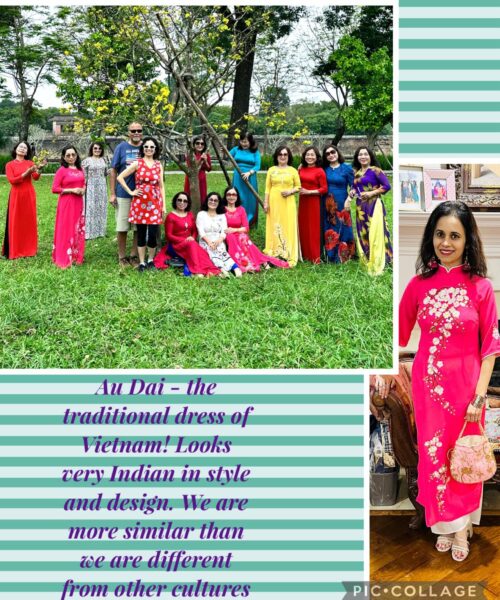
Hue
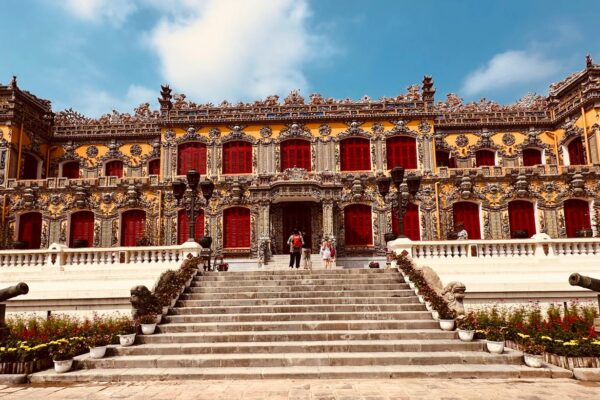
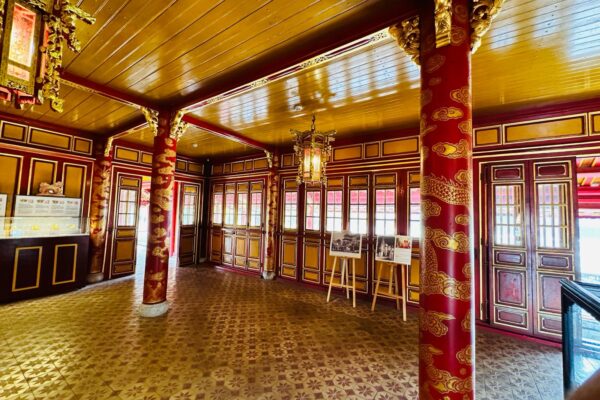
At Hue, there are beautiful imperial palaces from the 1800s and temples abound in Hue, the capital of this dynasty making it a must-see city for history lovers!
- Spectacular imperial palace of the NGUYEN dynasty started in 1802 by the first emperor Gia Long and mausoleum of emperor. Tu Doc, the longest ruling emperor, who was rendered in fertile by smallpox, and had over hundred wives with no children.
- Have you wondered about the name Nguyen (pronounced like Wen or Win) like I have?! This is the most well-known last name in Vietnam akin to Patel in India and Smith in UK. Apparently almost 70% of Vietnam’s population carries this name from the last dynasty founded by Nguyen feudal Lord Gia Long in 1802. There were 13 emperors, and the last one Bao Dai abdicated the throne when Vietnam adopted communism in 1945. Emperor Tu Duc was the longest reigning monarch for 36 years but sadly despite having over 100 wives his infertility from smallpox prevented the production of a biological heir. According to our local travel guide, Emperor Ming Mang the 2nd, was the most powerful and had over 500 wives with 142+ known heirs in the early 1800’s. His enduring DNA has probably passed on to millions. No wonder the Nguyen name has surpassed the Trinh, Tran, Le, Ly, Vo, Hoang, Huynh, Trieu and other Vietnamese last names we’ve come across in the USA!!
- I cannot wait to tell all my awesome Nguyen friends that I visited their great great great great great grandparent’s house!!
Our last destination in Vietnam was Ho Chi Minh City, also known as Saigon. We flew from Hue to Ho Chi Minh.
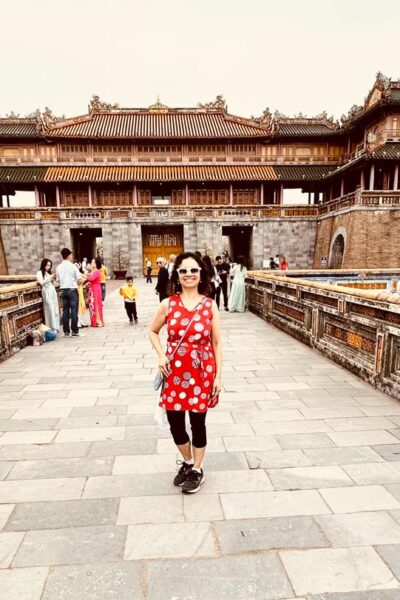
Ho Chi Minh City
- Cu Chi Tunnels in the morning.
- Ho Chi Min city tour
- Reunification palace, War museum, Notre Dame church, Hindu temple.
- Beautiful old post office in the colonial French style to mail myself some souvenir postcards, Ben Thanh market, Guitar street!
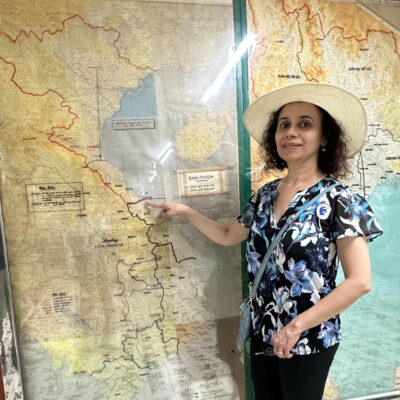
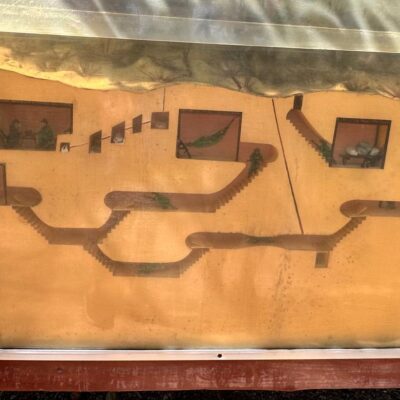
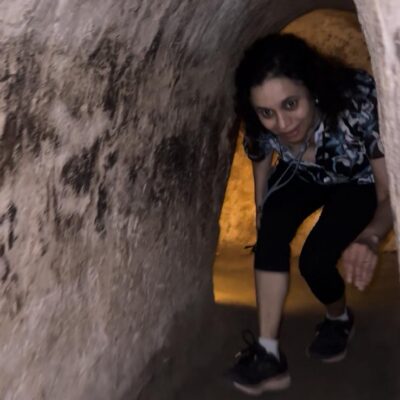
A History Lesson
The Vietnam war was one of the bloodiest longest wars ever fought in the world.
Have you come across a Vietnam Vet at work or read about it?
Ever wondered what this long drawn painful ~20 year old war (1954-1975) was all about?
I did……for a long time but my knowledge gaps were huge.
Had to make a trip to Saigon, Vietnam which served as the HQ of the American base to truly understand America’s role. Btw, the Vietnamese call it the “American” war.
Here it is in a nutshell as best as I comprehend it:
North Vietnam and South Vietnam were at loggerheads and wanted partition into 2 separate countries. The North was supported by Russia and China to some extent. USA 🇺🇸 was worried about communism spreading and decided to support South V. It was really a proxy war in the Cold War era! Americans had never really fought guerrillas and were shocked by the resistance put up by the fierce Viet Cong and North V soldiers. The revolutionaries built an extensive tunnel system spanning hundreds of miles underground where they hid from foreign invaders, lived with families, married, even had babies underground, made weapons and fought the American and South V back. Cu Chi tunnels located in Saigon is an example of this extensive underground network. American army tried to flush out these people by flooding the tunnels with water, bombs and poisonous gases. Special US soldiers called “tunnel rats” were trained to attack tunnel dwellers.
The 17th parallel was the line that divided North V from the South. Fortunately, the country remained whole despite America’s support of partition. The tunnels are so dark, dingy and narrow. Cannot even imagine the revolutionaries living, giving birth and raising children in these dark spaces. For 20 long years.
We have so much to be grateful for……..never take national security for granted.
Vegetarian and Vegan Food in Southeast Asian Countries
When it comes to local vegetarian food, these countries can pose a challenge. But there are always restaurants one can find, especially in bigger cities. Most restaurants will make you something vegetarian if you can communicate it well, unless it is very local with not much exposure to tourists and language is a big barrier. Even in places that cater to tourists, it is not very easy to convey, for example, that fish sauce is not ok. With Google translator or with the help of your English-speaking guide, you will manage. There are a lot of fresh fruits available and of course, healthy coconut water. If you like chips as a snack, you are in luck! Lots of jackfruit, banana and mango chips. Thai and Indian restaurants that have some vegetarian on their menu, can be found in many cities.
Please go to the Global Cuisine page on this site for more information on Asian vegetarian and a variety of other food.
Free Subscribe
If you have liked this page, here is a request from me to support the hard work! Thanks, it’s much appreciated!
- Leave a comment on this page (scroll down), share your own experiences if you have already been to this place.
- Subscribe to travelstosavour and receive 2 free blog posts per month, featuring 2 new destinations (scroll down to the footer to subscribe).
- Follow travelstosavour on social media – Facebook, Instagram and Youtube (by a click of the button in the footer) and share all the goodies with your pals!
Check out other destinations and nature escapes on this site.


Jyothi- you’re a superb storyteller and I loved my story told thru your words. Enjoyed the experience of reliving our entire journey thru this blog!!!
Thank you so much! 💖